SAMPLE
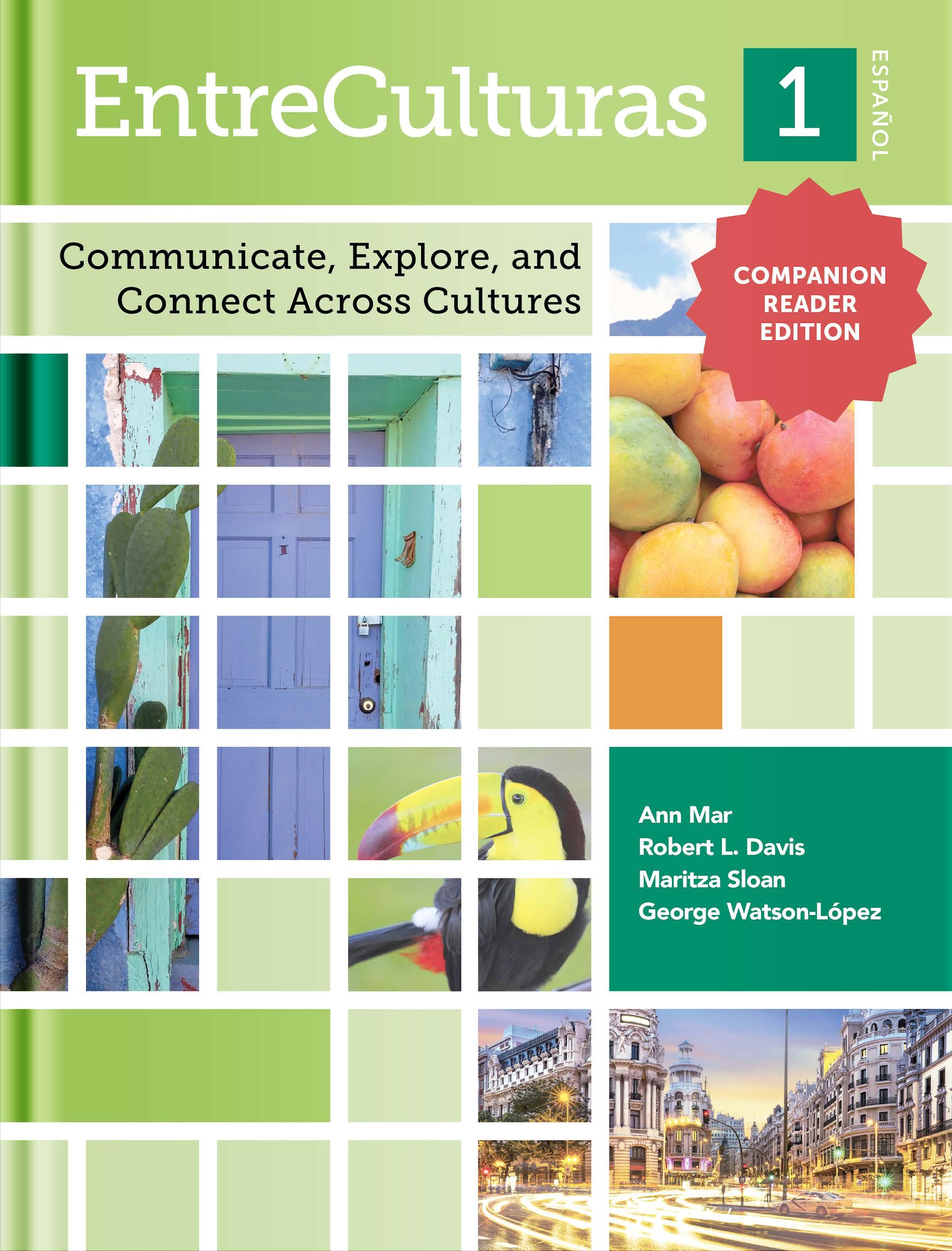


 Ann Mar Robert L. Davis Maritza Sloan George Watson-López
Ann Mar Robert L. Davis Maritza Sloan George Watson-López













All rights reserved. No part of this publication may be reproduced, stored in a retrieval system, or transmitted in any form or by any means, electronic, mechanical, photocopying, recording, or otherwise, without the prior written permission of the publisher.
The marks [EntreCulturas, EntreCultures, Explorer, FlexText, Learning Site, Wayside Publishing] (collectively “the Marks”) are registered in the U.S. Patent and Trademark O ce and owned in their entirety by Wayside Publishing (“Wayside”). Any use of the Marks without the express written permission of Wayside

The following expressions will help you understand instructions in class and carry out activities with your classmates.
Mandatos (Commands): singular - plural actúa - actúen dramatize apunta - apunten jotdown asigna - asignen assign busca - busquen lookfor cambia - cambien change compara - comparen compare comparte - compartan share comprueba - comprueben check/confirm contesta - contesten answer conversa - conversen converse convierte - conviertan convert crea - creen create decide - decidan decide di - digan say empareja - emparejen pair encuentra - encuentren find entrevista - entrevisten interview escribe - escriban write escoge - escojan choose


escucha - escuchen listen estudia - estudien study evalúa - evalúen evaluate explica - expliquen explain hazle(s) - háganle(s) askhim/her/ preguntas themquestions incluye - incluyan include indica - indiquen indicate investiga - investiguen research lee - lean read mira - miren watch nombra - nombren name piensa - piensen think pregúntale(s) - askhim/her/them pregúntenle(s)


pon - pongan put sé - sean be toma - tomen take trae - traigan bring

el compañero / la compañera classmate el dato fact el ejemplo example la imagen image el informe report la oración sentence la tabla table,chart el papel role la respuesta answer
Otras palabras y expresiones útiles a continuación whichfollow,below a la derecha ontheright a la izquierda ontheleft antes de before después de after hay thereis/thereare luego then/later ¡ojo! attention!/watchout! otra vez again según accordingto siguiente following trabajando working
Palabras interrogativas
¿Cómo?
How?
¿Cuál? ¿Cuáles? Which/What?
¿Cuándo?
¿Cuánto/a?
When?
Howmuch?
¿Cuántos/as? Howmany?
¿Dónde?
Where?
¿Por qué? Why?
¿Qué?
What/Which?
¿Quién? ¿Quiénes? Who?
Expresiones útiles: Decir la hora
¿Qué hora es?
Es la 1:00 (una).
Whattimeisit?
It’soneo’clock.
Son las 2:00 (dos). It’stwoo’clock.
Son las 5:15 (cinco y cuarto). It'sfivefifteen.
Son las 3:30 (tres y media). It'sthreethirty.
Forminutesfrom:31to:59,therearethreewaystotell thetime.Forexample,for6:40:
Son las seis y cuarenta.
Son las siete menos veinte.
Faltan veinte para las siete.
Sevilla, España







We extend our sincere gratitude and appreciation to all who accompanied us on our journey from the conception to completion of the EntreCulturas program. We had the privilege to work with a committed, talented, and dependable professional team that served as our anchor throughout the development process.










Eliz Tchakarian, Senior Editor, and Janet Parker, Curriculum Development Coordinator, were dedicated partners who coached us every step of the journey and consistently helped us pull the pieces together for production. Megan McDonald, Lourdes Cuellar (editors and behind-the-scenes writers for the programs) and Kelsey Hare (permissions consultant) were instrumental and persistent with acquiring permissions for the authentic materials. We commend our outstanding editors, María Solernou, Ana Martínez Álvarez, and María Matilla whose advice and editing were indispensable to the completion of the series. Our series would not have been as truly authentic nor as interesting without the generous contribution of our international video bloggers, young people from across the Spanishspeaking world; thank you for sharing your lives with our readers!
We thank Anthony Saizon for the thoughtful design. Derrick Alderman and Rivka Levin, our talented and artistic production team, brought the manuscripts to life on the engaging and colorful pages of the final product. We thank Wayside Publishing Assistant Editors Nathan Galvez, Shelby Newsted, Sawyer McCarron, and Rachel Ross, who designed many of the beautiful graphics and graphic organizers used in the series in print and online.
The Wayside Publishing marketing team was led by manager Michelle Sherwood, who was assisted by Nicole Lyons. In collaboration with the Wayside Publishing Sales team, they successfully got the word out to Spanish teachers about EntreCulturas , a new instructional tool and innovative approach to developing students’ intercultural communicative competence.
This project was possible due to the leadership, vision, and wisdom of Wayside Publishing president, Greg Greuel, who believed in us to get the job done!


 Ann Mar, Robert L. Davis, Maritza Sloan, and George Watson-López
Manzanillo, Costa Rica
Ann Mar, Robert L. Davis, Maritza Sloan, and George Watson-López
Manzanillo, Costa Rica
Communicate effectively in more than one language in order to function in a variety of situations and for multiple purposes
Interpersonal Communication:
Learners interact and negotiate meaning in spoken, signed, or written conversations to share information, reactions, feelings, and opinions.
Communicate e ectively in more than one language in order to function in a variety of situations and for multiple purposes
Interact with cultural competence and understanding
Connect with other disciplines and acquire information and diverse perspectives in order to use the language to function in academic and careerrelated situations
Relating Cultural Practices to Perspectives:
Interpretive Communication:
Interpersonal Communication: Learners interact and negotiate meaning in spoken, signed, or written conversations to share information, reactions, feelings, and opinions.
Learners understand, interpret, and analyze what is heard, read, or viewed on a variety of topics.
Interpretive
Communication: Learners understand, interpret, and analyze what is heard, read, or viewed on a variety of topics.
Learners present information, concepts, and ideas to inform, explain, persuade, and narrate on a variety of topics using appropriate media and adapt ing to various audiences of listeners, readers, or viewers.
Relating Cultural Products to Perspectives:
Learners use the language to investigate, explain, and reflect on the relationship between the practices and perspectives of the cultures studied.
Interact with cultural competence and understanding
Making Connections:
Learners build, reinforce, and expand their knowledge of other disciplines while using the language to develop critical thinking and to solve problems creatively.
Relating Cultural Practices to Perspectives: Learners use the language to investigate, explain, and re ect on the relationship between the practices and perspectives of the cultures studied.
Learners use the language to investigate, explain, and reflect on the relationship between the products and perspectives of the cultures studied.
Acquiring Information and Diverse Perspectives:
Presentational Communication: Learners present information, concepts, and ideas to inform, explain, persuade, and narrate on a variety of topics using appropriate media and adapting to various audiences of listeners, readers, or viewers.
Relating Cultural Products to Perspectives: Learners use the language to investigate, explain, and re ect on the relationship between the products and perspectives of the cultures studied.
Learners access and evaluate information and diverse perspectives that are available through the language and its cultures.
Develop insight into the nature of language and culture in order to interact with cultural competence
Connect with other disciplines and acquire information and diverse perspectives in order to use the language to function in academic and career-related situations
Communicate and interact with cultural competence in order to participate in multilingual communities at home and around the world
Language Comparisons:
Learners use the language to investigate, explain, and reflect on the nature of language through comparisons of the language studied and their own.
Making Connections: Learners build, reinforce, and expand their knowledge of other disciplines while using the language to develop critical thinking and to solve problems creatively.
Cultural Comparisons:
Learners use the language to investigate, explain, and reflect on the concept of culture through comparisons of the cultures studied and their own.
Acquiring Information and Diverse Perspectives: Learners access and evaluate information and diverse perspectives that are available through the language and its cultures.
School and Global Communities:
Learners use the language both within and beyond the classroom to interact and collaborate in their community and the globalized world.
Develop insight into the nature of language and culture in order to interact with cultural competence
Communicate and interact with cultural competence in order to participate in multilingual communities at home and around the world
Language Comparisons: Learners use the language to investigate, explain, and re ect on the nature of language through comparisons of the language studied and their own.
Lifelong Learning:
Learners set goals and reflect on their progress in using languages for enjoyment, enrichment, and advancement.
Cultural Comparisons: Learners use the language to investigate, explain, and re ect on the concept of culture through comparisons of the cultures studied and their own.
School and Global Communities: Learners use the language both within and beyond the classroom to interact and collaborate in their community and the globalized world.
Lifelong Learning: Learners set goals and re ect on their progress in using languages for enjoyment, enrichment, and advancement.
Learners maintain an online Mi portafolio to self-assess, reflect, and upload evidence for each Can-do statement displayed alongside activities in the Student Edition. Building their collections of artifacts allows learners to form vital habits leading them to efficiently continue learning beyond the classroom.






With EntreCulturas, learners explore and compare Spanishspeaking communities to their own communities. Video blogs created by native speakers allow learners to compare their lives with those of their peers. Activities and assessments are based on authentic sources and set in reallife thematic and cultural contexts.



















Our vision is a world where language learning takes place through the lens of interculturality, so learners can discover appropriate ways to interact with others whose perspectives may be different from their own.
Units include performance-based formative assessments, En camino, which solidify culturally appropriate communication skills relating to learners’ communities. Vive entre culturas, summative integrated performance assessments, engage learners in global intercultural contexts. Analytic rubrics that include intercultural and communicative learning targets accompany summative assessments.

The online Explorer provides all audio/video resources; scaffolding for Student Edition activities; vocabulary and grammar reinforcement, including flipped classroom videos; additional activities; formative and summative assessments; rubrics; and other teacher resources.





In the Teacher Edition, you are provided audio and audiovisual transcripts, answer keys, instructional strategies, Can-do statements for each unit, and rubrics. Indices include a Grammar and Learning Strategies Videos Index as well as a Grammar Index. Glossaries are in the Student Edition.

EntreCulturas is a three-level, standards-based, thematically-organized program consisting of 19 in-depth units that provide learners with opportunities to interact and engage with authentic materials and adolescent speakers of the language. By learning in an intercultural context, students acquire communication skills and content knowledge while exploring the products, practices, and perspectives of Spanish-speaking cultures.
EntreCulturas aims to prepare learners to communicate, explore, and connect across cultures in order to foster attitudes of mutual understanding and respect.






Our vision is a world where language learning takes place through the lens of interculturality, so students can discover appropriate ways to interact with others whose perspectives may be different from their own.



In today’s world, we all live entre culturas : That is, we live around and among people and influences from a variety of cultures. As we live, learn, work, and play in our communities and abroad, we interact in person and online with people whose experiences and perspectives may be different from our own.




The learning materials in the EntreCulturas program were designed to help you communicate in Spanish, and to develop the attitudes and habits of mind to interact appropriately with Spanish speakers, respecting differences and recognizing the many things we share as human beings.



Thank you for the commitment you have made to learning another language. The opportunity to experience interactions across cultures and connect with diverse people in our communities and around the world has brought each of us great personal and professional satisfaction. We hope that through this program you too will embrace the opportunities that will come to you as you live entre culturas .
Sincerely,
Ann Mar, Robert L. Davis, Maritza Sloan, and George Watson-López

























































INDICATES













































VISUALS CLARIFYING MEANING WITHOUT TRANSLATION.










vocabulary
Strategies





























































MORE PRACTICE IN CONTEXT IN EXPLORER.







Actividad




Modelo
Estudiante




vegetariano/vegetariana












Formative assessment measures your progress towards unit goals.



FIND SUPPORTING MATERIALS IN EXPLORER.

A final assessment is set in an authentic cultural context.

FIND SUPPORTING MATERIALS IN EXPLORER.
Actividad

eres?

Un intercambio estudiantil
questions:




¿Quiénes son los estudiantes extranjeros?







Paso
Paso
the




A conocer
Información
Paso 3: ¿Quién habla?



Based on what the two
You will provide evidence of growing proficiency in Mi Portafolio in Explorer, which contains all Cando statements included throughout the unit.









Email: Permíteme presentarme











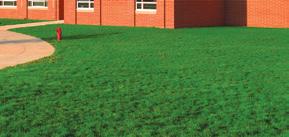
Mi primer video blog



This song was recorded by Los Tigres del Norte.
Paso 1: Mis experiencias
Working in groups of four, answer the following questions.
1. Do you listen to music with lyrics in Spanish? List several Latino or Spanish-language musical artists popular in your community.
2. What different styles of Latin music are you familiar with? Give specific examples.
Read “La música de los Tigres del Norte” in your Explorer course, and research the group using the Internet, your library, and/or other resources. Then share with a partner at least two interesting facts you learned.

1. Listen to “America” to determine its tone. Which of these adjectives describe the “feeling” of the song? Sad, happy, romantic, angry, lively, depressing?
2. Complete the following phrase, repeated several times in the song:
AMERICA, written by Enrique Franco. Published by TN Ediciones Musicales. Copyright Secured. Used by permission, all rights reserved.
3. Listen again while reading the lyrics, found in Explorer. As you listen and read, underline the cognates you find.
Producto cultural: Los mapas expresan la identidad
How many continents did you learn that there are in the world? In many English-speaking countries, students learn that there are seven: Africa, Antarctica, Asia, Australia, Europe, North America and South America. But in Latin American schools, students are taught that there are six: África, América, Antártida, Asia, Europa y Oceanía. In fact, in Latin America to be “americano/americana” means something di erent from being an “American” in the USA. It means that you are from any one of the countries which make up the Americas: North America, Central America and the Caribbean, or South America.
Conexiones
Go to the appropriate Explorer discussion forum to answer the Re exión intercultural below.

América: ¿una o más?

After reading the Enfoque cultural above, prepare two versions of the world map. One should show the six continents typically represented in Spanish, each a different color and labeled with Spanish names. The other map should have the seven continents and colors, with labels in English.
Why do you think los latinoamericanos see two continents as one? What do these continents share? The shape of the map of Texas is very recognizable. Are there maps that express identity where you live?
Share your observations in Explorer.





Knowing about cultural products, practices, and perspectives lays a foundation for intercultural reflections.
SHARE YOUR REFLECTIONS IN THE EXPLORER DISCUSSION FORUM.

After a variety of experiences with cultural products, practices, and perspectives, you will reflect on your growing intercultural awareness.
SHARE REFLECTIONS IN THE EXPLORER DISCUSSION FORUM.



Mi progreso intercultural
I can recognize different perspectives on the meaning of the word



This unique self-assessment feature clarifies intercultural goals.





Unidad 1 | Explora
The online Explorer is the other half of your textbook, connecting you with language learning resources that inspire continued exploration.
Whether learning about Paraguay through Maria Laura’s video blogs, studying grammar through flipped classroom videos, or updating language learning portfolios with new achievements, you can practice all modes of communication at your own pace and within your own comfort zone.







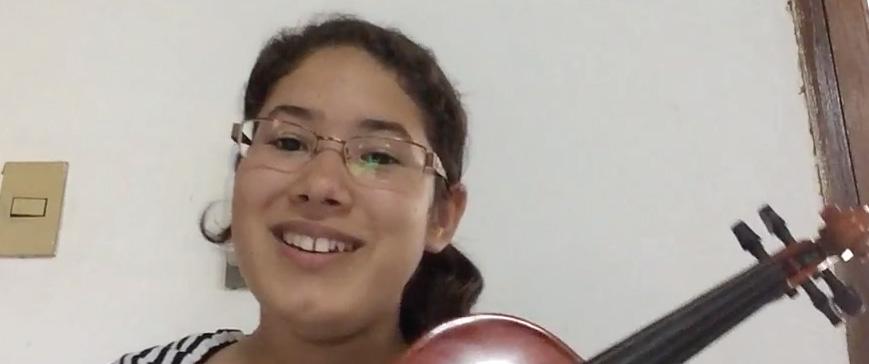













FlexText® is Wayside’s unique e-textbook platform. Built in HTML5, our digital textbook technology automatically adjusts the book pages to whatever screen you’re using for optimal viewing.
Your FlexText® can be accessed across all of your devices. And page by page, just like the printed textbook, FlexText® allows students and teachers to use EntreCulturas on the go.

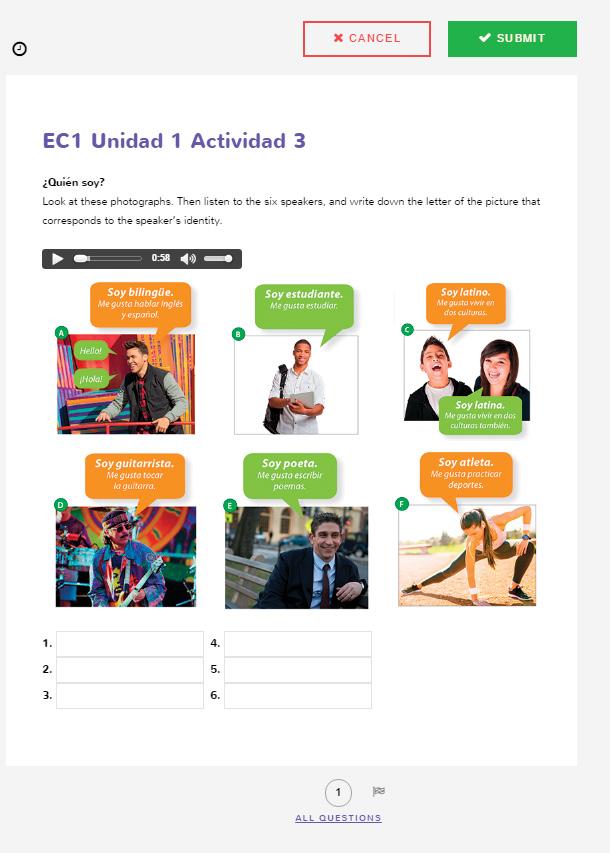











Interact in Spanish, asking and answering some questions to meet and get to know new people.
Interpret ads, charts, graphs, and images to learn about diverse places, people and cultures where Spanish is spoken.

Reflect on how to communicate respectfully when meeting people from other cultures.
How widely used is Spanish in the world, on the Internet, and in my community?
How do I begin a conversation when meeting a Spanish speaker?
What strategies will help me communicate in Spanish as I begin to learn the language?
Bienvenidos a EntreCulturas . . . . . . . . . . . . . . . . . . . . . . . . . . . 2
Meet six young people from the Spanish-speaking world
Compara . . . . . . . . . . . . . . . . . . . . . . . . . . . . . . . . . . . . . . . . . . . . . 6
El español en el mundo Comunica
Así se dice 1 Saludos y despedidas . . . . . . . . . . . . . . . . . . . . . 10
Greetings and good-byes
Exchanging personal information
Así se dice 2 El alfabeto español . . . . . . . . . . . . . . . . . . . . . . . 15
The alphabet
The numbers from 1-31
Estrategias Intercultural strategy . . . . . . . . . . . . . . . . . . . . . 17
Así se dice 3 El calendario . . . . . . . . . . . . . . . . . . . . . . . . . . . . 18
The months, days of the week, and seasons
Detalle gramatical: Las fechas . . . . . . . . . . . . . . . . . . . . . . . 19
Explora . . . . . . . . . . . . . . . . . . . . . . . . . . . . . . . . . . . . . . . . . . . . . 28
Campamento audiovisual
Estrategias Los cognados . . . . . . . . . . . . . . . . . . . . . . . . . 29
Vocabulario. . . . . . . . . . . . . . . . . . . . . . . . . . . . . . . . . . . . . . . . . . 30
Vive entre culturas: Cursos de verano . . . . . . . . . . . . . . . . . . . . 31
Interpretive Reading Assessment
Interpersonal Speaking Assessment

Compara . . . . . . . . . . . . . . . . . . . . . . . . . . . . . . . . . . . . . . . . . . . .
Paraguay y Texas
Comunica . . . . . . . . . . . . . . . . . . . . . . . . . . . . . . . . . . . . . . . . . . .
Video blog: Soy María Laura . . . . . . . . . . . . . . . . . . . . . . . . . . . 40
Así se dice 1 ¿Quién soy? . . . . . . . . . . . . . . . . . . . . . . . . . . . . . 42
Observa 1 ¿Quién soy? . . . . . . . . . . . . . . . . . . . . . . . . . . . . . . . 46
Express identity with ser
Detalle gramatical: El verbo ser . . . . . . . . . . . . . . . . . . . . . . 47
Así se dice 2 Mis actividades favoritas . . . . . . . . . . . . . . . . . . 49
Activities
Observa 2 Mis actividades favoritas . . . . . . . . . . . . . . . . . . . . 52
Express likes with me gusta
Así se dice 3 Preguntas y respuestas . . . . . . . . . . . . . . . . . . . 56
Questions words Languages
Detalle gramatical: ¿Qué? vs. ¿Cuál? . . . . . . . . . . . . . . . . . . 57
Observa 3 Preguntas y respuestas . . . . . . . . . . . . . . . . . . . . . 58
Ask and answer questions
Estrategias Listening Strategy . . . . . . . . . . . . . . . . . . . . . 60
Enfoque en la forma Affirmative, Negative and Interrogative Sentences
Síntesis de gramática . . . . . . . . . . . . . . . . . . . . . . . . . . . . . . . . . 62
Vocabulario. . . . . . . . . . . . . . . . . . . . . . . . . . . . . . . . . . . . . . . . . . 64
En camino: Formative assessment . . . . . . . . . . . . . . . . . . . . . . . 66
Explora . . . . . . . . . . . . . . . . . . . . . . . . . . . . . . . . . . . . . . . . . . . . . 68
Los idiomas y la identidad La música y la identidad En mi comunidad ¡Exploremos la ciudad!
SUMMATIVE ASSESSMENT
Vive entre culturas: Un intercambio estudiantil . . . . . . . . . . . 80
Audiovisual Assessment
Writing Assessment
Interact in Spanish to express your identity, ask for and give personal information and express preferences about activities.
Interpret images, video, audio and written texts in Spanish to gain insights into identity.
Present basic information about yourself in Spanish. Investigate, explain, and reflect on the role of language and music in shaping identity in Paraguay, in Texas, and in your community as well.
Who am I? How does what I do define who I am?
How am I similar to and different from young people in the Spanishspeaking world?
How do language and music shape identity?
Exchange information about your life at school, including people, places, calendars, schedules, and student activities. Interpret images, videos, schedules, and calendars to gain insights into what school life is like in Costa Rica.
Present information about your own life at school.
Investigate and reflect on how a country’s educational system mirrors cultural values and perspectives.
What places, people, and activities define student life?
How is student life at my school similar to and/or different from student life at a school in Costa Rica? How do schools reflect the values of their communities?
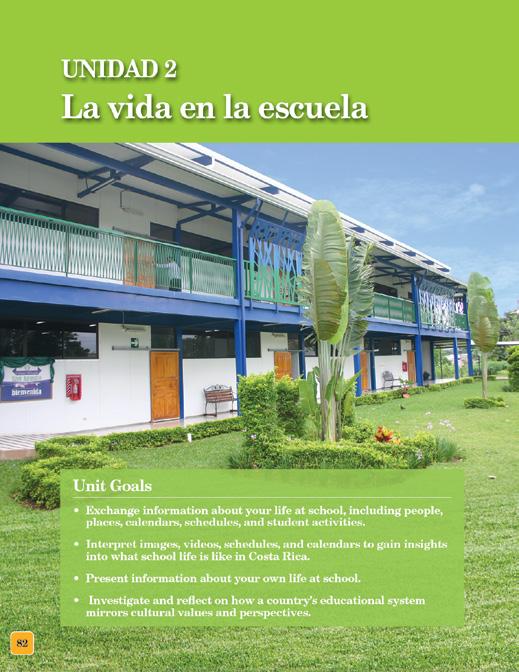
Compara . . . . . . . . . . . . . . . . . . . . . . . . . . . . . . . . . . . . . . . . . . . . 84
Costa Rica y California
Comunica . . . . . . . . . . . . . . . . . . . . . . . . . . . . . . . . . . . . . . . . . . . 87
Video blog: Soy Isaac . . . . . . . . . . . . . . . . . . . . . . . . . . . . . . . . . 88
Así se dice 1 ¿Qué necesitamos para la escuela? . . . . . . . . . . 90
School supplies and uniforms
The numbers from 30–1000
Detalle gramatical: Possession with de . . . . . . . . . . . . . . . . 93
Observa 1 Escuelas diferentes . . . . . . . . . . . . . . . . . . . . . . . . . 94
Gender of nouns; definite articles
Así se dice 2 Mi día en la escuela . . . . . . . . . . . . . . . . . . . . . . 98
Estrategias Listening for cognates . . . . . . . . . . . . . . . . 99
School subjects
Places in school
Detalle gramatical: ¿A qué hora? . . . . . . . . . . . . . . . . . . 100
Observa 2 ¿Qué hay en mi colegio? . . . . . . . . . . . . . . . . . . . . 102
Hay + indefinite articles and quantity words Detalle gramatical: Hay . . . . . . . . . . . . . . . . . . . . . . . . . . . 103
Así se dice 3 ¿Qué hacemos en la escuela? . . . . . . . . . . . . . . 106
School activities
Detalle gramatical: El infinitivo en español. . . . . . . . . . . . 107
Observa 3 Una entrevista con Isaac . . . . . . . . . . . . . . . . . . . 110
-ar verbs in present tense. Detalle gramatical: Subject pronouns . . . . . . . . . . . . . . . . 112
Enfoque en la forma
Subject pronouns
Síntesis de gramática . . . . . . . . . . . . . . . . . . . . . . . . . . . . . . . . 116
Vocabulario. . . . . . . . . . . . . . . . . . . . . . . . . . . . . . . . . . . . . . . . . 120
En camino: Formative assessment . . . . . . . . . . . . . . . . . . . . . . 122
Explora . . . . . . . . . . . . . . . . . . . . . . . . . . . . . . . . . . . . . . . . . . . . 124
La importancia de la educación
La educación y los valores
En mi comunidad: Los valores de mi escuela
Vive entre culturas: Un programa de hermandad con una escuela en Costa Rica . . . . . . . . . . . . . . . 134
Interpretive Audiovisual Assessment Interpersonal Writing Assessment Presentational Speaking Assessment
Compara . . . . . . . . . . . . . . . . . . . . . . . . . . . . . . . . . . . . . . . . . . . 138
España y Colorado
Comunica . . . . . . . . . . . . . . . . . . . . . . . . . . . . . . . . . . . . . . . . . . 141
Video blog: Soy Marina. ¿Os acordáis de mí? . . . . . . . . . . . . . 142
Así se dice 1 Esta es mi familia . . . . . . . . . . . . . . . . . . . . . . . 144
Family members; Personal characteristics
Observa 1 ¿Cómo son las personas de mi familia? . . . . . . . . 150
Describe family members with adjectives
Detalle gramatical: Los adjetivos . . . . . . . . . . . . . . . . . . . . 151
Así se dice 2 Mi casa, mi hogar . . . . . . . . . . . . . . . . . . . . . . 154
Types and locations of homes; Parts of the house
Observa 2 ¿Dónde está? . . . . . . . . . . . . . . . . . . . . . . . . . . . . . 160
Identify location with estar and prepositions
Detalle gramatical: El verbo estar . . . . . . . . . . . . . . . . . . . 161
Detalle gramatical: Las contracciones . . . . . . . . . . . . . . . . 161
Estrategias Conversation strategies . . . . . . . . . . . . . . 163
Así se dice 3 ¿Qué te gustaría hacer mañana . . . . . . . . . . . . 164 Activities with family and friends Expressions of obligation and frequency Detalle gramatical: El verbo ir . . . . . . . . . . . . . . . . . . . . . . 165
Observa 3 ¿Qué hacen los españoles en familia? . . . . . . . . . 168
Present tense of -er and -ir verbs, and of ir Detalle gramatical: Formas irregulares de YO . . . . . . . . . . 169
Enfoque en la forma
Present tense of -er and -ir verbs
Síntesis de gramática . . . . . . . . . . . . . . . . . . . . . . . . . . . . . . . . 174
Vocabulario. . . . . . . . . . . . . . . . . . . . . . . . . . . . . . . . . . . . . . . . . 176
En camino: Formative assessment . . . . . . . . . . . . . . . . . . . . . . 178
Explora . . . . . . . . . . . . . . . . . . . . . . . . . . . . . . . . . . . . . . . . . . . .
La familia une las generaciones Las familias unen las culturas En mi comunidad: ¿De dónde vienen tus familiares, de cerca o de lejos? Reading strategy

Vive entre culturas: Familia nueva, cultura nueva . . . . . . . .
Interpretive Reading Assessment Interpersonal Speaking Assessment Presentational Writing Assessment
Exchange information in Spanish about home life and family.
Interpret short texts about family structure and activities.
Prepare and present a collection of images and descriptions to share information about your home, family, and friends. Explore traditions, languages, people, and the geography of Spain and Colorado.
Who makes up my family?
What places and activities bring us together as a family? How is my family similar to and different from families in the Spanish-speaking world?
Share preferences, opinions, and habits about food choices and food purchases. Interpret photographs, videos, ads, blogs, and menus to understand food traditions.
Create and present a series of menu items based on your food preferences and food traditions from a Spanishspeaking country.

Recognize how traditions relating to meals and food reflect identity and how sharing in the food of another culture opens doors to intercultural communication.
What are some iconic foods from the Spanishspeaking world?
How do food products and food practices shape our cultural identity? How can exploring new foods lead me to new intercultural experiences?
Compara . . . . . . . . . . . . . . . . . . . . . . . . . . . . . . . . . . . . . . . . . . . 198
México y Carolina del Norte Comunica . . . . . . . . . . . . . . . . . . . . . . . . . . . . . . . . . . . . . . . . . . 201
Video blog: Soy Christian . . . . . . . . . . . . . . . . . . . . . . . . . . . . 202
Así se dice 1 En el mercado de la Merced . . . . . . . . . . . . . . . 204
Fruits, vegetables, drinks and other foods; Colors
Observa 1 ¿Qué quieren ustedes? . . . . . . . . . . . . . . . . . . . . . 210
Express food preferences using stem changing verbs
Detalle gramatical: Otros verbos con e--> ie . . . . . . . . . . . . . . 211
Detalle gramatical: The verbs almorzar and poder . . . . . . 213
Así se dice 2 ¿Qué quieres comer? . . . . . . . . . . . . . . . . . . . . . 214
Meals; Favorite foods
Observa 2 ¿Qué comidas te gustan? . . . . . . . . . . . . . . . . . . . 216 Express food preferences using gustar and encantar
Detalle gramatical: ¿A quién le gusta? . . . . . . . . . . . . . . . . . 219
Así se dice 3 ¡Me encanta comer en la calle! . . . . . . . . . . . . . 222
Street foods of Mexico Adjectives to describe flavors
Tener expressions
Detalle gramatical: Los verbos e--> i . . . . . . . . . . . . . . . . . 223
Observa 3 ¿Cómo está la comida? . . . . . . . . . . . . . . . . . . . . . 224 Detalle gramatical: Los demostrativos . . . . . . . . . . . . . . . . 224
Estrategias Elaboration and detail . . . . . . . . . . . . . . . 225
Enfoque en la forma Stem changing verbs
Ask about and react to how food tastes using estar + adjectives
Síntesis de gramática . . . . . . . . . . . . . . . . . . . . . . . . . . . . . . . . 228
Vocabulario. . . . . . . . . . . . . . . . . . . . . . . . . . . . . . . . . . . . . . . . . 230
En camino: Formative assessment . . . . . . . . . . . . . . . . . . . . . . 232
Explora . . . . . . . . . . . . . . . . . . . . . . . . . . . . . . . . . . . . . . . . . . . . 234
La comida expresa nuestras raíces
La comida nos une
En mi comunidad: Festivales de comida: Celebraciones de identidad local
Vive entre culturas: Los camiones de comida . . . . . . . . . . . . . 246
Interpretive Reading Assessment
Interpersonal Writing Assessment Presentational Writing Assessment
Compara . . . . . . . . . . . . . . . . . . . . . . . . . . . . . . . . . . . . . . . . . . . 250
La República Dominicana y Nueva York
Comunica . . . . . . . . . . . . . . . . . . . . . . . . . . . . . . . . . . . . . . . . . . 253
Video blog: Hola, soy Paola . . . . . . . . . . . . . . . . . . . . . . . . . . . 254
Así se dice 1 ¿Qué haces los sábados? . . . . . . . . . . . . . . . . . . 256
Leisure activities
Expressions of physical and emotional states
Detalle gramatical: El verbo jugar . . . . . . . . . . . . . . . . . . . 259
Observa 1 ¿Qué vas a hacer en las vacaciones? . . . . . . . . . . 260 Express plans using ir+a+infinitive Express physical and emotional states with estar+adjective
Detalle gramatical: El verbo ir . . . . . . . . . . . . . . . . . . . . . . 262
Así se dice 2 ¿Quieres ir conmigo? . . . . . . . . . . . . . . . . . . . . 264
Expressions for making social plans
Estrategias Study and practice . . . . . . . . . . . . . . . . . . 265
Observa 2 ¡Vamos a la fiesta en metro!. . . . . . . . . . . . . . . . . 270
Affirmative and negative expressions
Así se dice 3 Fiestas y festivales . . . . . . . . . . . . . . . . . . . . . . 274
Community celebrations Reactions to events
Observa 3 ¿Qué hiciste ayer? . . . . . . . . . . . . . . . . . . . . . . . . . 278
Ask and answer questions about recent leisure activities using the yo and tú forms of the preterit.
Detalle gramatical: El pretérito (yo and tú forms of tomar, correr, escribir, hacer and ir) . . . . . . . . . . . . . . . . . . . . . . 280
Enfoque en la forma
Uses of the verb ser
Síntesis de gramática . . . . . . . . . . . . . . . . . . . . . . . . . . . . . . . . 282
Vocabulario. . . . . . . . . . . . . . . . . . . . . . . . . . . . . . . . . . . . . . . . . 284
En camino: Formative assessment . . . . . . . . . . . . . . . . . . . . . . 286
Explora . . . . . . . . . . . . . . . . . . . . . . . . . . . . . . . . . . . . . . . . . . . . 288
Celebremos las tradiciones
El béisbol y el dominó nos unen
En mi comunidad: ¡Vamos a jugar!
Vive entre culturas: Vamos a visitar Santo Domingo . . . . . . 300 Interpretive Reading Assessment
Interpersonal Writing Assessment
Presentational Speaking Assessment
Express preferences for leisure activities. Make simple social plans. Interpret print and audiovisual material about the Dominican Republic celebration of Carnaval.
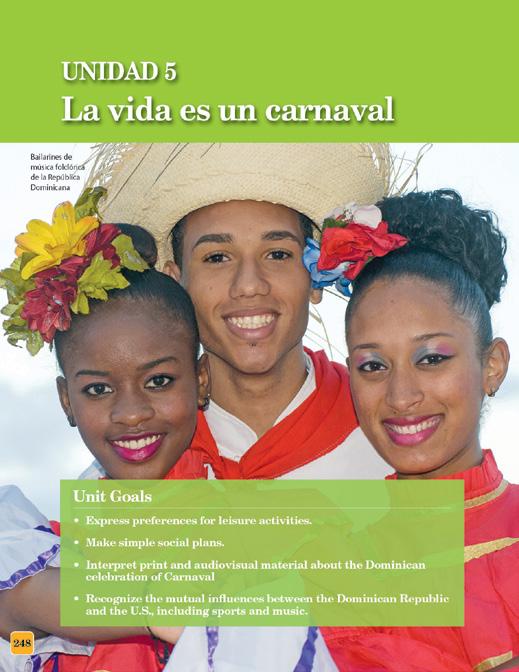
Recognize the mutual influences between the Dominican Republic and the U.S., including sports and music.
What leisure activities help to define my community and me? How do celebrations reflect the history and culture of a place? How do leisure activities create bridges between cultures?
Share information, opinions, and preferences about weather, clothing, outdoor activities, and the natural surroundings in your community and in the Spanish-speaking world. Interpret blogs, promotional materials, and reports on climate and weather to plan your day.

Create and present travel information for Spanish-speakers who are planing to visit your community.
Identify some of the unique geographical features that have shaped and defined the culture of a community.
How do the culture, climate, and the people around us affect how we live, work, and play?
What makes a place unique?
How do my surroundings shape my identity?
. . . . . . . . . . . . . . . . . . . . . . . . . . . . . . . . . . . . . . . . . . . 304
Colombia y Florida Comunica . . . . . . . . . . . . . . . . . . . . . . . . . . . . . . . . . . . . . . . . . . 307
Video blog: Soy Melissa . . . . . . . . . . . . . . . . . . . . . . . . . . . . . . 308
Así se dice 1 Entornos para todos los gustos . . . . . . . . . . . . 310 Geographical features Weather conditions
Observa 1 ¿Qué tiempo hace en Colombia? . . . . . . . . . . . . . 314 Hacer with weather expressions Expressions of frequency Detalle Gramatical: Cómo identificar y describir . . . . . . . 316
Así se dice 2 Actividades turísticas para todos . . . . . . . . . . 318 Activities for visitors Expressions to make recommendations
Observa 2 ¿Qué estás haciendo en esta foto? . . . . . . . . . . . . 322 Describe ongoing activities using the present progressive
Así se dice 3 ¿Qué ropa llevo? . . . . . . . . . . . . . . . . . . . . . . . . 326 Clothing
Observa 3 Mi pasaporte en 2030 . . . . . . . . . . . . . . . . . . . . . . 330 Expressing future plans Saber and conocer
Estrategias Discover Ways to use Spanish Outside Class . . . . . . . . . . . . . . . . . . . . . . . . 333
Enfoque en la forma Uses of the verb estar
Síntesis de gramática . . . . . . . . . . . . . . . . . . . . . . . . . . . . . . . . 334
Vocabulario. . . . . . . . . . . . . . . . . . . . . . . . . . . . . . . . . . . . . . . . . 336
En camino: Formative assessment . . . . . . . . . . . . . . . . . . . . . . 338
Explora . . . . . . . . . . . . . . . . . . . . . . . . . . . . . . . . . . . . . . . . . . . . 340
El transporte nos conecta La historia nos conecta y define En mi comunidad: Ideas de hoy para el futuro
Vive entre culturas: Promoción para turismo a mi comunidad . . . . . . . . . . . . . . . . . . . . . . . . . . . . . . . . . . . . . 352
Interpretive Audiovisual Assessment Presentational Speaking Assessment Interpersonal Speaking Assessment




Who am I? How does what I do define who I am?
How am I





and different from



There are many sides to our identity. We may be students, athletes, artists and volunteers. In this unit you will learn to talk with Spanish speakers about who you are, and start to develop another aspect of your identity: bilingual communicator connecting across cultures.



Discover some ways Paraguay and Texas are similar and different by exploring a timeline and images of some of the landscapes and products that shape identity in these two places.




Learn to ask and answer the questions you will need to exchange information with a Spanish speaker about your identity and things you like to do.



Learn to express identity (ser), state preferences about activities we like and dislike (me gusta/te gusta + infinitive), and ask and answer questions.



Use graphs, ads, and music to discover how bilingualism and music define identity in Paraguay and Texas. Explore these aspects of identity in your community, and compare perspectives on identity.

Show how well you can communicate with young people from a Spanish-speaking culture. First, watch two teenagers introduce themselves in their video blogs. Then, respond to one of them with a simple email message. Finally, prepare your own video blog, introducing yourself in Spanish.


































Paso 1


















Look at the images on this page. Which could represent aspects of Paraguayan identity? Which could represent Texas? Explain your answers.



Paso 2


What are some of the objects or places associated with the identity of people from the place you live?




The Paraguayan harp, the national instrument of Paraguay

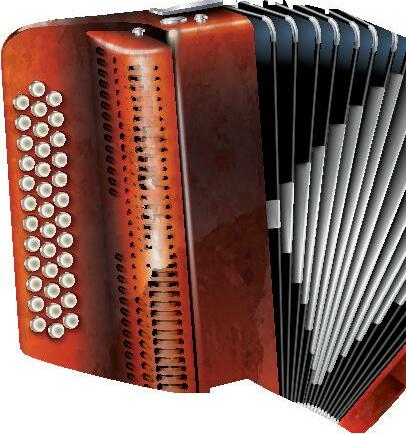















Meet María Laura through her video blog. As you watch and listen, you’ll reflect on what you have in common with this young person from a rural community in Paraguay.
Learn the vocabulary you need to talk about your identity in Spanish.

Learn to ask and answer questions to share information about your identity with Spanish speakers.
Learn to ask about and express some preferences by saying what you do and do not like to do.


Learn to ask and answer questions to share information about your favorite activities.
Learn question words to get more details about your friends’ and family's interests.
Learn to ask for and exchange additional information about age, origin, and the languages you speak.
Síntesis de gramática y vocabulario 62
Assess your progress. Show what you have learned, and discover areas where you need more practice to reach your learning goals.
La bandera (flag) paraguaya. ¿Tiene colores en común con la bandera de Texas?















Actividad 2
Look at the picture of María Laura. What kind of information do you think she has included in her video blog? What do you think the phrases in the speech bubbles mean?













Listen to the video blog recording and raise your hand when you think you hear María Laura say the words from the picture captions.



















Listen and watch again. Based on what you see and hear, write two sentences about what you think Laura is telling us in her video blog.



How is María Laura similar to you and/or other young people in your community? How is she different? Share your observations in class and in EntreCulturas 1 Explorer.




Mi progreso intercultural
I can recognize some similarities and differences between a Paraguayan teen and myself.
































bilingüe.









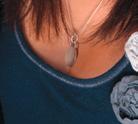

















estudiante.




Soy latino.






Soy latina.


Soy guitarrista.
Soy poeta.



Soy atleta.





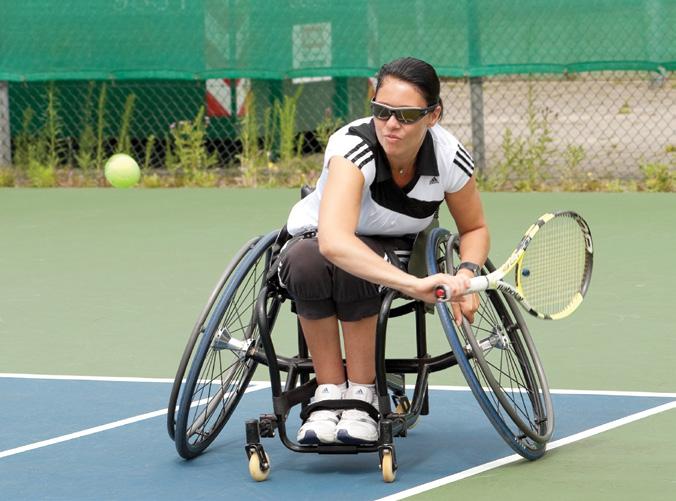


Your teacher will ask you a series of questions about your identity. Listen carefully and follow the model to respond.
Modelo
Profesor: ¿Eres bilingüe?
Estudiante: Sí, soy bilingüe./No, no soy bilingüe.


Paso 1


Look at the list of identities in the chart and choose sí or no in the first column (under Yo ) to indicate if they correspond to your identity.
Identidades Yo Compañero/a 1Compañero/a 2Compañero/a 3 guitarrista sí/no latino/latina* sí/no estudiante sí/no bilingüe sí/no poeta sí/no atleta sí/no
*Use latina if the person is a girl or woman, and latino if the person is a boy or man.
Paso 2


Ask questions to three of your classmates, following this pattern, and record their answers in the chart in Paso 1.
Modelo
Estudiante A : ¿Eres guitarrista ?

Estudiante B : No, no soy guitarrista.
Estudiante A : ¿Eres estudiante ? Estudiante B : Sí, soy estudiante.
are two forms listed, the

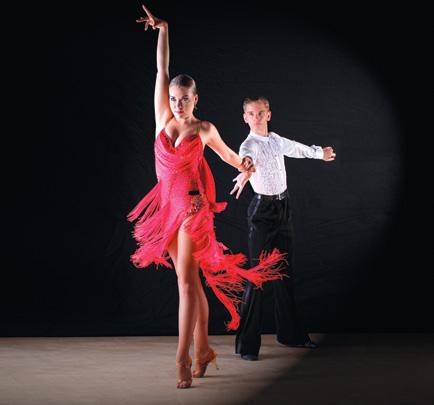
one refers to a boy or man, and

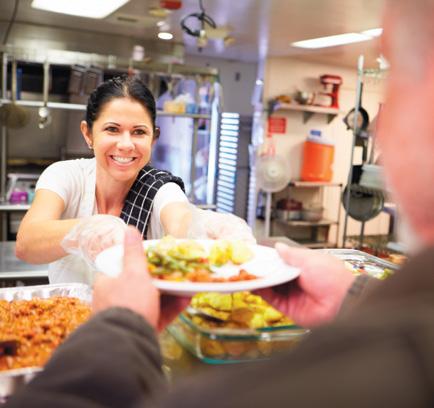
second one to a girl or woman.


that the masculine forms
end in -o, and the feminine




in -a. Words that end in -ista
to males or females.

One’s profession is often an important part of identity. Can you match these famous Spanish speakers with their identity? Converse with your partner, connecting the person’s name and identity with es , as in the model. Look up the people you don’t know, or consult a classmate to fill in the gaps in your knowledge.
Estudiante A : ¿Javier Bardem?
Estudiante B : Javier Bardem es actor.

1. Lionel Messi actor/actriz
Carlos Santana artista
Pablo Picasso entrenador/entrenadora
Shakira músico/cantante
Gael García Bernal futbolista
Selena Gómez ciclista
Alberto Contador
Penélope Cruz
Ron Rivera
Marc Anthony
Mi progreso comunicativo
I can ask and answer questions to share information about identity.



































Read the dialogue above and notice the words in bold used to introduce identities ( eres , soy ). Can you figure out when to use eres and soy ? Discuss with classmates and teacher, view the Observa 1 resources for this unit in your Explorer course, and check the Síntesis de gramática at the end of this section to help you find out.





Paso 1
Look at these words. Select and write five that describe your identity. Don’t let anyone see your words! actor/actriz entrenador/entrenadora
pianista artista estudiante poeta atleta fotógrafo/fotógrafa profesor/profesora bilingüe
Paso 2
bailarín/bailarina futbolista gimnasta voluntario/voluntaria bloguero/bloguera guitarrista ciclista latino/latina vegetariano/vegetariana
The verb ser is one way to express identity in Spanish
(yo) soy I am (tú) eres you (familiar, informal) are
(ella) es she is (él) es he is
(---) es it is
Working with a compañero or compañera, ask questions like the one in the model until you discover a word on your partner’s list. Then switch roles and answer your partner’s questions. NOTE: Read the Detalle gramatical on pronouns, and notice that you don’t need them in this interchange!
Modelo
Estudiante A : ¿Eres atleta?
Estudiante B : Sí, soy atleta./No, no soy atleta.
The words in parentheses above are subject pronouns, like I, you, he, she in English. But Spanish doesn’t use these pronouns the way English does. If you study the examples in this chapter, you’ll see that the verb alone tells you who is talking: soy = I am . Also, there is no subject pronoun for “it”! Just use the verb: Es = it is .
Mi progreso comunicativo
I can ask and answer questions about my identity.
Mi progreso comunicativo

I can write sentences to express other people's identity.





See how many sentences you can write about the identities of your compañeros de clase and your teacher. Use the following models.
Modelos
Sophia es artista.

El Sr. Brown no es estudiante.

El Sr. Brown es profesor.



























Ella es bailarina.
Listen to the speakers share their favorite activity, and select the correct identity.
1. a. futbolista
2. a. fotógrafa
3. a. ciclista
a. gimnasta

5. a. poeta
a. atleta
7. a. pintor
guitarrista
voluntaria
actor
bailarina
estudiante
artista
entrenador
Which of these sentences are logical? Rewrite the illogical sentences so they make sense.
1. Soy atleta; me gusta tocar el piano.
2. Soy artista; me gusta pintar.
3. Me gusta escribir poemas; soy poeta.
4. Soy entrenador; me gusta tocar la guitarra.
5. Soy vegetariana; me gusta comer hamburguesas.
6. Soy actriz; me gusta trabajar en la comunidad.

Richard Blanco is the rst Latino poet to read a poem at a U.S. presidential inauguration (Barack Obama, 2012). Born in Madrid to Cuban parents, his family moved to the U.S. when he was an infant; and he was raised and educated in Miami, Florida. In 2015 Richard was honored again when he was asked to read his poem “Cosas del
mar”/“Matters of the Sea” at the reopening of the American embassy in Havana, Cuba.
Research the life and career of Richard Blanco. How does he self-identify both personally and professionally? How are poets celebrated in our community?
El poeta hispano Richard Blanco recitó un poema durante la inauguración del Presidente Obama en 2013.
Which activity is associated with each person described below? Select the logical option.

1. Soy capitán del Real Madrid. Me gusta al fútbol. a. escribir b. tocar c. jugar
2. Soy bailarina del Ballet Folklórico de México. Me gusta .
a. surfear b. bailar c. hablar
3. Soy estudiante en la Universidad de Miami. Me gusta biología. a. estudiar b. pintar c. comer
4. Soy Fernando Botero, el artista más famoso de Colombia. Me gusta . a. estudiar b. jugar c. pintar
5. Soy el famoso poeta Richard Blanco. Soy bilingüe. Me gusta poemas y me gusta español e inglés. a. surfear/participar b. escribir/hablar c. trabajar/pintar
6. Soy voluntario para Hábitat para la Humanidad. Me gusta en la comunidad. a. bailar b. trabajar c. jugar
7. Soy Carlos Santana. Me gusta la guitarra. a. comer b. participar c. tocar
8. Soy vegetariano. No me gusta hamburguesas. a. estudiar b. vivir c. comer
El Ballet Folklórico de México es una expresión de la cultura mexicana.
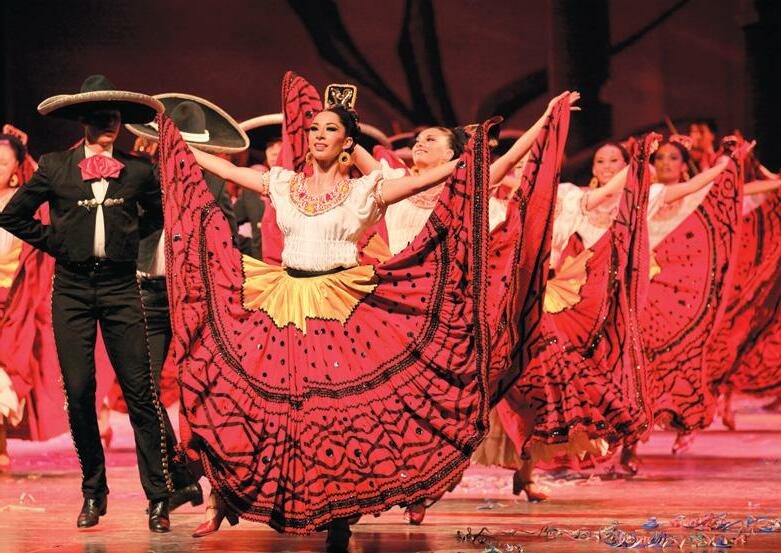
Soy voluntario para Hábitat para la Humanidad.






Read the dialogue and notice the words in bold. Can you figure out when to use me gusta and te gusta ? Discuss with classmates and teacher, view the Observa 2 resources for this unit online in Explorer, and check the Síntesis de gramática at the end of this section to help you find out.




actividades favoritas
¿ te gusta jugar al tenis?
¿te gusta jugar al golf?
no me gusta .
observas?
me gusta mucho.



¿Qué actividad te gusta?
Paso 1
Look at these words. Select and write five (5) activities you like to do. Don’t let anyone see your words!










comer hamburguesas/verduras jugar practicar deportes/gimnasia/yoga escribir mirar películas tocar la guitarra escuchar música montar en bicicleta trabajar en la comunidad/ estudiar en un campamento de fútbol participar pintar hablar español ¿…?


Paso 2


Work with a compañero or compañera . Ask and answer questions like the ones in the model. Include some of the useful expressions in the sidebar at the right to react to your partner’s answer.
Modelo






Estudiante A : Emily, ¿te gusta practicar deportes?





Estudiante B : Sí, me gusta practicar deportes.

Estudiante A : Ah, eres atleta. ¡Qué bueno!

Estudiante A : Jacob, ¿te gusta tocar la guitarra? Estudiante C : No, no me gusta tocar la guitarra. Estudiante A : Ah, no eres guitarrista.










You can react and express interest in what people tell you in Spanish by using the following expressions.
¡Qué interesante! Interesting!
¡Qué bueno! Great!
¡Qué pena! Too bad!
I can identify key words when I read in Spanish.






You are going to a language immersion camp next summer, and you have to pick a roommate for your cabin.



Look at the notes posted on the camp website by four possible roommates to find out about their interests. Select the one most compatible with you. Copy the phrases that indicate things you have in common.

¡Hola! Me llamo Ignacio
Sánchez Villalobos. Soy de Málaga, España. Tengo 15 años y me gusta surfear, practicar yoga y hacer gimnasia.
No me gusta pintar, escribir poemas o tomar fotos.
Mi nombre es Natalia Romero Maldonado.


Soy de Asunción, Paraguay y tengo 14 años. Me gusta hablar inglés y practicar francés, pero no me gusta practicar deportes.


Paso 2
Write a note to the student you have chosen to be your roommate. Introduce yourself and include the following information. You can use their notes as a model.
• your name
• your age (tengo años)
• origin (where you are from)
• 3 things you like to do
• 3 things you don’t like to do
¡Hola! Mi nombre es Alejandro Bottaro. Tengo 16 años, y soy de Buenos Aires, Argentina. Me gusta escribir música, bailar y montar en bicicleta. Soy vegetariano, no me gusta comer hamburguesas o pizza.

¡Hola! Soy Daniela Martínez, y tengo 15 años. Soy de Brownsville, Texas. Me gusta jugar al fútbol, básquetbol y pintar, pero no me gusta mucho bailar o tocar instrumentos.
Mi progreso comunicativo






I can write a short note in which I introduce myself and tell what I like and dislike.








¿ Cómo te llamas? — Me llamo Michelle González.
¿ De dónde eres? — Soy de Texas.
¿ Cuántos años tienes? — Tengo 15 años.
¿ Cuándo es tu cumpleaños? — El 29 de mayo.
Hablas bien español. ¿ Quién es tu profesor? — Es el señor Smith.
¿ Por qué estudias español? — Porque me gusta viajar a otros países.

¿ Cuál es tu país favorito? — Paraguay, ¡por supuesto!
Match the questions on the left with the logical answers on the right.
1. ¿Cómo te llamas?
2. ¿Cómo se escribe Diego?
3. ¿De dónde eres?
4. ¿Cuántos años tienes?
Conversación con Graciela
1. ¿Cómo estás?
¿Quién eres?
¿Qué idiomas hablas?
¿Qué estudias?
5. ¿Cuándo es tu cumpleaños?
a. Se escribe D-I-E-G-O.
Soy de El Paso.
Tengo dieciséis años.
Me llamo Diego.
a. Hablo español y guaraní.
b. Soy estudiante de medicina en la Universidad Nacional de Asunción.
Es el primero de mayo.
Estoy bien, gracias. ¿Y tú?
Soy Graciela.

¿Qué? vs. ¿Cuál?
The English question “what?” is expressed with ¿Qué? when giving a defi nition. We use ¿Cuál(es)? for all other cases. ¿Cuál(es)? can also be translated as “Which one(s)”?
¿ Cuál es tu bebida favorita?
¡El mate, por supuesto!

¿ Qué es el mate?
El mate en una guampa, un recipiente hecho de un cuerno (horn).
What is your favorite drink?
Mate, of course!
What is mate?
Es un té típico de Paraguay y otros países. It’s a typical tea from Paraguay and other countries.
Listen to these questions and choose the logical answer.
1. a. Me llamo Jorge. b. Se escribe J-O-R-G-E.c. Soy atleta.
2. a. Soy María. b. Soy estudiante.c. Soy de Dallas.
3. a. Soy José. b. Soy artista.
c. Soy de Chile.
4. a. Tengo dos hamsteres.b. Tienes diecisiete años. c. Tengo catorce años.
5. a. Estoy muy bien. b. Soy latino.
c. Me llamo Manuel.
6. a. Hablas español e italiano.b. Tengo quince años. c. Hablo español e inglés.
7. a. Me gusta jugar al tenis.b. Te gusta jugar al golf. c. Me gusta hablar español.
Write down five questions in Spanish that will allow you to find out interesting information about your classmates. Then interview each other to get to know each other better. Keep practicing until you can ask and answer questions confidently. Then, record your interview in your Explorer course.
Mi progreso comunicativo
I can ask and answer a few questions to get to know another person.




















Are you and your classmates the same age? Ask five of them this question to find out.








Estudiante A : ¿Cuántos años tienes?
Estudiante B : Tengo catorce años.
Estudiante A : Ah, yo tengo quince años.
Estudiante A : ¿Cuántos años tienes?





Estudiante C : Tengo quince años.
Estudiante A : Ah, ¡yo también!
What languages have you heard in the media, or spoken in your home, school, or community? List the languages you think you have heard, and write in others that you have heard that are not on the list.
¿Hablas español?


María Laura from Paraguay speaks two languages, español y guaraní. Here are the names of some other languages you may have heard. Add to the list any other languages you or your friends speak or want to learn more about. alemán árabe chino español francés guaraní inglés italiano polaco portugués tagalo vietnamita

When listening to Spanish, relax! You won't understand everything. Your goal for now is to understand a few familiar words and phrases as you listen. With practice, you will understand more.
Watch the listening strategies video in Explorer for more tips to help you understand spoken Spanish.

Is your class multilingual? Ask your classmates questions to find out what languages they speak. Follow the model, paying careful attention to the different forms of the verb hablar ( hablo , hablas ). Include an appropriate expression such as ¡Qué interesante! ¡Qué pena! or ¡Qué bueno! to acknowledge your classmate’s answer.
Estudiante A: ¿Hablas italiano ?
Estudiante B: No, no hablo italiano.
Estudiante A: Ah, ¡qué pena!
Estudiante B: ¿Hablas inglés ?

Estudiante A: Sí, hablo inglés.
Estudiante B: ¡Qué bueno!




The video you are about to see is a trailer for a documentary film from Paraguay about the relationship of garbage (basura) from a landfill and music. Can you guess what that relationship is? Write down two ideas and share with a partner.
You will hear the following words in the video. Before watching the video, list all the words that relate to music and verify with your class.
instrumentos estómago violín tocar personas chelo vida orquesta feliz música casa basura ñoqui comunidad
Watch the video, listen carefully, and complete the information about Ada and Juan Manuel in the chart.
Nombre Edad (age) Instrumento Ada Tengo añosToco el chelo/la flauta/el violín
Juan Manuel… (Bebi)Tengo añosToco el chelo/la flauta/el violín
You have been asked to create an inspirational documentary film about your community. Write a brief proposal for the film including the topic and two scenes you would include. Begin by outlining your proposal in the chart. Share with a partner and take notes about your classmate’s proposal.



Tema
Escenas Cateura, Paraguaylos instrumentos reciclados de la basura1. el basurero
2. la orquesta
In this unit, you have seen that verbs in Spanish change their form depending on the subject of the sentence:

— ¿ Hablas español?
Do you speak Spanish?
— Sí, hablo español, y francés también.
Yes, I speak Spanish, and French too.
The form used for yo usually ends in -o , and the tú form ends in -as or -es . Some verbs do not follow this pattern; they are irregular. In this unit, you have seen three forms of the verb ser (to be) ; all the present tense forms are given below:
1st Person (yo) soy I am (nosotros) somos we are
2nd Person (tú) eres you are (informal) (vosotros) sois you (plural) are (usted) es you are (formal) (ustedes) son you (plural) are
3rd Person (él, ella) es he, she is (ellos, ellas) son they (people) are es it is son they (things) are
Questions with a yes/no answer in Spanish sound just like the statement, but with rising intonation at the end. You can optionally add a subject pronoun ( yo , tú , etc.) after the verb to emphasize who is doing the action.
— ¿Hablas español?
Do you speak Spanish?
— ¿Eres tú guitarrista?
Are you a guitar player?

Note that there are no words in the Spanish question that correspond to English do or does.

Information questions require a question word or phrase ( ¿Qué?, ¿Cómo?, ¿Cuántos años? , etc.). In this type of question, the question phrase goes first, followed by the verb:










— ¿Cuántos años tienes?


How old are you?
— Pablo, ¿de dónde eres?
Pablo, where are you from?
Again, a pronoun ( yo , tú , etc.) can be added after the verb for emphasis. Note that question words always require a written accent mark, and Spanish uses an inverted question mark to show where the question begins.
In Spanish, you can ask about a friend’s likes and dislikes using ¿Te gusta ? , with the infinitive form of a verb ( -ar, -er, -ir ) in the blank. To answer the question, use Me gusta .
To make the sentence negative, add no before te gusta or me gusta .

Do you like to paint?



— Sí, me gusta pintar , pero no me gusta escribir poemas. Yes, I like to paint, but I don’t like to write poems.


I can talk about who I am (Así se dice 1) ¿Quién soy? el actor/la actriz el/la artista el/la atleta el bailarín/ la bailarina bilingüe el/la bloguero/a el/la ciclista el/la compañero/a de clase el/la entrenador/a el/la estudiante el/la fotógrafo/a el/la futbolista el/la gimnasta el/la guitarrista el poeta/ la poeta el/la vegetariano/a el/la voluntario/a



actor artist athlete dancer bilingual blogger cyclist classmate trainer, coach student photographer football (soccer) player gymnast guitarist poet vegetarian volunteer



I can say what I like to do (Así se dice 2)
Mis actividades favoritas bailar comer escribir poemas estudiar escuchar música hablar jugar (al baloncesto) mirar películas navegar en/por internet pintar practicar deportes tocar un instrumento trabajar vivir









to dance to eat to write poems to study to listen to music to speak, talk to play (basketball) to watch movies to surf the web to paint to practice sports to play an instrument to work to live

I can ask a few questions to get to know another person (Así se dice 3)

Palabras interrogativas Question words



¿Cómo?
¿Cuál?

¿Cuándo?
¿Cuánto/a?
¿Cuántos/as?
¿(De) dónde?
¿Por qué?
¿Qué?
¿Qué te gusta hacer?
¿Cómo te llamas?
¿Por qué estudias español?
¿De dónde eres?

¿Cuál es tu deporte favorito?
¿Cuántos años tienes?
¿Cuándo es tu cumpleaños?
How? What?
Which one? What?
When?
How much?
How many?
Where (from)?



Why?
What?
What do you like to do?
What’s your name?
Why are you studying Spanish?
Where are you from?
What is your favorite sport?





How old are you?
When is your birthday?
I can say what languages I speak
¿Qué lenguas hablas? alemán chino español francés guaraní inglés italiano portugués ruso vietnamita

What languages do you speak? German Chinese Spanish French Guarani English Italian Portuguese Russian Vietnamese

Expresiones útiles también
¡Yo también!
¡Qué interesante!
¡Qué bueno!
¡Qué pena!
also
Me too!
Interesting! Great ! Too bad!

Think of four people you know well and who are different from each other. Can you think of words and sentences you have learned in Spanish to talk about their identities? List as many as possible for each person. you a member of your family a classmate another classmate



progreso comunicativo
I can talk about my identity and the identity of others.





an adult in your community

Actividad 22
¿Quién eres? Paso 1





Write as many questions as you can that you could ask of a classmate you don’t know yet.








Paso 2

Pair up with a student in your class whom you have not yet met. Use the questions from Paso 1 to find out as much as you can about him/her.
Mi progreso comunicativo
I can ask and answer questions to get to know another person.

You have decided to compete for a state-wide scholarship to help fund the cost of going to a Spanish-speaking country as part of an exchange program. In order to introduce yourself to the scholarship committee (made up of Spanish teachers), you have decided to create a slide show that describes you, the activities you like, and how you self-identify. Your presentation should include at least:
four slides containing only images
symbols, etc.)
your narration for two slides
a minimum of eight sentences
ninety seconds in length.
Paso 1
You will hear a dialog between a newly arrived Spanishspeaking exchange student and his bilingual guidance counselor at a high school in Texas. Look at the grid below, listen for the required information, and fill in the cells.
Paso 2
How is the student in the dialog similar and/or different from you and other students at your school? If this student were coming to your community, what school activities, groups or classes do you think he would enjoy? List at least two people you think he should meet, and three classes, clubs or activities you would recommend, and explain your choices.

Mi progreso comunicativo
I can introduce myself and provide some details about myself.
Mi progreso intercultural
I can recognize some similarities and differences between young people from the Spanish-speaking world and myself.














Essential Question: How do language and music shape identity? Overview





People around the world study new languages and enjoy music from different cultures. In this segment you will explore ads promoting language study in Paraguay and Texas, and hear some music that will help you gain insight into these two cultures. Finally, explore language learning and musical identity in your own community.
Compare charts showing statistics about language use in Paraguay and Texas and read advertisements for language classes in both places as you gain insight into the importance of learning languages in every community.

Gráfico Los idiomas hablados en Paraguay y Texas








Anuncio Aprender guaraní




Discover some musical sounds that capture and reflect identity in Paraguay and Texas.
Pieza musical paraguaya Pájaro campana
Música norteña de Los Tigres del Norte América
Explore language and musical identity in your community and share your findings in a visual presentation.
Read this bilingual sign from an airport terminal What do the pictures, arrows, letters and numbers communicate? In what other places would you expect to find bilingual signs?

you or some people you know bilingual or multilingual?
each person you know, make a list of (1) languages they speak and (2) how they learned their languages.
list with your

many
people can become bi- or multi-lingual.
Look at the pie graphs below. Write at least three sentences about languages in Paraguay and Texas, and how these places are similar and/or different.
Mi progreso intercultural
I can recognize some similarities and differences between bilingualism in Paraguay and Texas.
en inglés
en inglés
español
en español
en inglés y otro idioma
en otro idioma
Mba’éichapa
ha nde
vos?
26
This
the Instituto Superior de
Filosóficos de Paraguay.
You are going to read the ad “Aprender guaraní de forma fácil, divertida y práctica”, which appeared on a website

in Paraguay. Before you read the ad, work with a partner to answer the following questions:
What catches your attention first?
Describe the image and the layout of information on the page.
Paso 2: Predicciones
Study the large words in the illustration “Curso de guaraní coloquial”
answer these questions:
Who might be interested in reading this ad?
What kind of information would they expect to find in the ad?
You are interested in the course advertised in this ad. Can you find the following information? Jot down the information you find, but be careful—not all the information is included.
1. The name of the class
2. The name of the textbook
3. What you will learn in the course
4. The day classes are held
5. How many months the course lasts
How to find out more information
Find the Spanish words/phrases in the ad to express the following:

1.learn
2. class or course
3.practical
4. oral expression
Answer the following questions and share with your classmates.
1. What does “14 a 17 hs” mean in the context of the ad?
2. In this ad the word guaraní refers to two different things. What are they?
Mi progreso comunicativo
I can understand the main ideas and some details from an ad for a language program.
I can understand and compare some cultural perspectives on the importance of language learning.
As you read the ad, were you able to “read between the lines” to pick up on some cultural perspectives of people in Paraguay? Work with a partner to answer the following questions, then compare cultural perspectives about language learning and use in Paraguay and your community.
1. Why do you think the Instituto Superior chose the class times advertised for this course?
2. How is the class in the ad similar to your Spanish class? How is it different?
3. What are some reasons a person in Paraguay would want to take this class?
4. What are some of the reasons you decided to study Spanish?
5. When others make an effort to learn your language, what does that tell you about them?




What opportunities are there to learn languages in your community other than at your school? Is there a community college or language institute? What languages are offered? Find websites, ads, flyers or other promotional materials announcing language learning opportunities. Share with your class using the model.































En , ofrecen (they offer) clases de y .





En Portland State University, ofrecen clases de vietnamita y ruso.

El pájaro campana es el ave nacional de Paraguay.





Working with two or three classmates, answer these questions.
1. Make a list of the kinds of music (styles, artists, etc.) that you enjoy the most.
2. Is there a special musical style or musical instrument that people associate with your community or region— Cajun music in Louisiana, bluegrass music in Kentucky, etc.? What are some of the characteristics of this music: instruments, rhythm, theme of lyrics? Do you personally identify with this music? Does the music remind you of where you are from? Upload a link and a brief description of this music to the discussion forum in Explorer.
Look at the photograph of a typical instrument from Paraguay, el arpa paraguaya . Then explore the website Paraguayanharps.com, and write three things you learned about the instrument and/or the company.

1. According to the photo caption at the right, how does the pájaro campana interact with others? What words does the text use to indicate the bird’s behavior?
2. Use the links in Explorer to listen to recordings of “El pájaro campana”. Do you think the music accurately reflects the bird’s behavior, as described in the caption?

3. Now search the Internet for the terms “pájaro campana Paraguay,” and note how many results you find. What does the quantity of results tell you about the importance of this symbol for Paraguayans’ national identity? What symbols would you be likely to find in a search for your region’s identity?
1. Review your answers in the previous activity about how the pájaro campana interacts with others of its species. Since this bird is a national symbol, what might this tell you about how Paraguayans see themselves (i.e., their national identity)?
2. Choose one of the options below, or add your own perspective on this Paraguayan symbol.
a. Es importante cantar más fuerte ( louder ) que otros pájaros.
b. Somos miembros de una comunidad, y la comunicación es importante.
c. La música es más importante que la naturaleza.
La canción “El pájaro campana” imita la vocalización del ave en la naturaleza. Empieza (it begins) con el canto de un pájaro. Otro pájaro contesta (answers), y después la música se convierte en un coro o una sinfónica de pájaros.
"Dueling Harp" Rendition of Classic "Pájaro Campana" by Martin Portillo and Marcelo Rojas, CFV10179, Image Courtesy of Smithsonian Folkways Recordings, (p) (c) 2009. Used by permission.

AMERICA, written by Enrique Franco. Published by TN Ediciones Musicales. Copyright Secured. Used by permission, all rights reserved.
This song was recorded by Los Tigres del Norte.
Working in groups of four, answer the following questions.
1. Do you listen to music with lyrics in Spanish? List several Latino or Spanish-language musical artists popular in your community.
2. What different styles of Latin music are you familiar with? Give specific examples.
Read “La música de los Tigres del Norte” in your Explorer course, and research the group using the Internet, your library, and/or other resources. Then share with a partner at least two interesting facts you learned.

1. Listen to “America” to determine its tone. Which of these adjectives describe the “feeling” of the song? Sad, happy, romantic, angry, lively, depressing?
2. Complete the following phrase, repeated several times in the song:
3. Listen again while reading the lyrics, found in Explorer. As you listen and read, underline the cognates you find.

How many continents did you learn that there are in the world? In many English-speaking countries, students learn that there are seven: Africa, Antarctica, Asia, Australia, Europe, North America and South America. But in Latin American schools, students are taught that there are six: África, América, Antártida, Asia, Europa y Oceanía. In fact, in Latin America to be “americano/americana” means something di erent from being an “American” in the USA. It means that you are from any one of the countries which make up the Americas: North America, Central America and the Caribbean, or South America.
Go to the appropriate Explorer discussion forum to answer the Re exión intercultural below.


Actividad 35
After reading the Enfoque cultural above, prepare two versions of the world map. One should show the six continents typically represented in Spanish, each a different color and labeled with Spanish names. The other map should have the seven continents and colors, with labels in English.



Why do you think los latinoamericanos see two continents as one? What do these continents share?
The shape of the map of Texas is very recognizable. Are there maps that express identity where you live? Share your observations in Explorer.
Mi progreso intercultural
I can recognize different perspectives on the meaning of the word América





























What languages are present in your community? As a class, prepare a list of people to talk to and places to explore, considering the following:
Family members, neighbors and friends
Classmates, teachers and school staff
US Census Factfinder data

Radio and television stations


Local newspapers and magazines
Local shops and restaurants
Churches and community centers




Select one or more of the areas in Paso 1 to explore, and bring back to class your evidence of languages in your community.
Work with your group or class to create your visual presentation. Write at least a short caption in Spanish for each visual element.

Present your results to your classmates, another class in your school, or use technology to share with a class at another campus or in another country.






Answer these questions also available in your Explorer course in the form of a discussion forum.
1. Did anything your class discovered about languages in your community surprise you?
2. What are some situations in which you might encounter Spanish speakers in your community?

3. How will knowing some Spanish affect your interactions?


Mi progreso intercultural
I can recognize ways in which languages and language learning impact me and my community.
CENTRAL HIGH SCHOOL SAN ANTONIO, TEXAS ENROLLMENT FORM FOR FOREIGN EXCHANGE STUDENTS
M.


Name: Isaac M.
Age: Home Address: City: Palmares Country of Birth/Residence:


CENTRAL HIGH SCHOOL SAN ANTONIO, TEXAS
• Who am I? How does what I do define who I am?
• How am I similar to and different from some young people in the Spanish-speaking world?
Your school has been chosen to participate in an exchange program bringing students from Latin America and Spain to your community. You have volunteered to host one of the students in your home for three weeks.
Get acquainted with Isaac and Marina, two of the exchange students, by watching the video blogs they have sent to your school.


Number of Siblings: Brothers Languages (conversational proficiency):



ENROLLMENT FORM FORFOREIGN EXCHANGE STUDENTS

Name: Marina F.
Home Address: General Martínez Campos 20 City: Country of Birth: Dominican Republic
Number of Siblings: Brothers Sisters
Number of pets: Languages (conversational proficiency): , , , vasco

Watch each video blog of Isaac and Marina. Using the graphic organizer in your Explorer course, mark the words you hear. Compare your list with a compañero/a de clase .
Watch the video blogs again to learn everything you can about Isaac and Marina. Note what you learn on your organizer. You may need to infer some of the details.
Using the checklist in Explorer, identify the characteristics of each video blogger.
Based on what the two students said in their video blogs, which student would you like to host in your home during his or her three-week stay in your community?

Write an email to introduce yourself to one of the exchange students, following the instructions in Explorer.








You will create a video blog to share with the family you will stay with when you and your classmates travel to Spain or Costa Rica next summer. Follow the directions in Explorer to create and share your video.

Of the three video bloggers you have met in this unit, who is the most similar to you? Copy and complete the sentences and share with a compañero/a de clase in the discussion forum in Explorer.
Yo soy similar a María Laura/Isaac/Marina porque (because) yo soy y él/ella también.
Yo soy similar a María Laura/Isaac/Marina porque me gusta y a él/ella también le gusta.
I can identify places where Spanish is spoken around the world.*
I can recognize the importance of Spanish as a language of real-world and online communication.
I can recognize and use appropriate words, gestures, and body language to greet people in different cultures.
I can recognize differing cultural perspectives on the seasons in areas with different climates.
I can ask and answer questions to meet and greet a young person in an appropriate manner.
I can understand and write out some common names in Spanish when I hear them or hear them spelled.
I can spell out my first and last name using the Spanish alphabet.
I can understand and say days, dates, and months in Spanish.
I can read and interpret an ad in Spanish.
I can understand a short spoken presentation in which a native speaker of Spanish introduces him or herself.
can respond orally to several questions about myself.
I can recognize some similarities and differences between a Paraguayan teen and myself.
I can recognize some similarities and differences between young people from the Spanish - speaking world and myself.
I can recognize some similarities and differences between bilingualism in Paraguay and Texas.
I can understand and compare some cultural perspectives on the importance of language learning.
I can recognize different perspectives on the meaning of the word América .
I can recognize ways languages and language learning impact me and my community.
I can ask and answer questions to share information about identity.
I can ask and answer questions about my identity.
I can write sentences to express other people’s identity.
I can identify key words when I read in Spanish.
I can write a short note in which I introduce myself and tell what I like and dislike.
I can ask and answer a few questions to get to know another person.
I can talk about my identity and the identity of others.
I can introduce myself and provide some details about myself.
I can understand the main ideas and some details from an ad for a language program.
I can recognize some similarities and differences between school life in Costa Rica and in my community.
I can identify some shared values between my community and a community in the Spanish-speaking world.
I can compare cultural practices and perspectives reflected in the use of uniforms in my community and in Costa Rica.
I can identify cultural practices from authentic digital materials.
I can write a list of school supplies I need to purchase.
I can express where my school activities take place.
I can understand a simple written ad in Spanish.
I can create a simple written promotional message.
I can present information about my school day orally.
I can write a simple description of my personal preferences about school.
I can ask and respond to questions relating to personal preferences about school activities.
I can ask and answer questions about life at school in oral conversations.
I can list in writing a few of the activities I regularly do at school.
I can identify and interpret familiar words when I hear students talking about their school.
I can present information about my school and extracurricular activities in writing.
I can interact orally to exchange information about my activities.
I can identify key details from charts and graphs, and make inferences about cultural perspectives.
I can identify key details and understand cultural practices when reading authentic print materials.
I can create a written presentation communicating school values.
I can understand how family and given names reflect identity in some Spanishspeaking cultures.
I can compare across cultures who makes up a family and how long people live together at home.
I can compare typical family activities across different cultures.
I can identify key details and cultural practices from authentic reading materials.
I can identify common elements in family history across cultures.
I can can ask and tell about family members and pets.
I can write simple messages to compare information about my family and others.
I can describe the members of my family.
I can ask and answer questions about family members and where they live.
I can talk about where I live.
I can talk about places in the house.
I can propose activities to do with others.
I can understand basic descriptions of families and the activities they do together.
I can understand simple texts about family activities.
I can talk about family members and pets.
I can identify and interpret familiar words when I hear a person talk about his or her family.
I can write phrases and simple sentences to compare and contrast family activities.
I can identify key words, the theme, and some details in a poem about the family.
I can identify key details from charts and graphs and make inferences about cultural perspectives.
I can understand and identify key ideas in a Spanish blog post.
I can recognize some similarities and differences between foods in México and in my community.
I can identify some foods typically enjoyed in some Spanish-speaking communities at different meals and at different times of day.
I can recognize how my food habits and preferences reflect my culture, and compare that with those of young people in Spanishspeaking countries.
I can identify examples demonstrating how foods reflect interactions between cultures.
I can identify opportunities to create intercultural experiences.
I can identify basic foods and describe their color.
I can specify the quantity of foods for purchase.
I can ask and answer questions about preferences for food and drink.
I can talk about what I eat at different meals, and what time I eat them.
I can order street food from a vendor.
I can state personal reactions to the tastes of food.
I can interpret a simple menu and choose foods I would like to sample.
I can talk about similarities and differences in foods across cultures.
I can produce brief written descriptions of foods from the target culture.
I can order foods from a basic menu or menu board.
I can explain the cultural importance of activities and celebrations to the identity of my community.
I can understand basic conventions for communicating in different media, like text messages.
I can recognize similarities and differences between my own leisure activities and those of young people in the Spanish-speaking world.
I can recognize ways sports can bridge cultural differences.
I can state likes or dislikes and preferences relating to leisure activities.
I can ask and answer questions in a conversation about leisure activities that I like to do everyday or during the weekends.
I can describe future plans and actions.
I can invite friends to social and cultural events and accept invitations.
I can turn down invitations politely.
I can describe social norms and rules for events and celebrations in my community.
I can make simple social plans.
I can describe my preferences for celebrating holidays.
I can describe typical activities associated with celebrations in my community.
I can talk about what I did on a recent weekend, at a party, or an event.
I can understand short presentations about preferences for leisure activities.
I can describe community events and celebrations.
I can say a few activities that I did recently.
I can exchange information about what I am going to do.
I can recognize some ways geography impacts culture.
I can outline plans for intercultural experiences now and in my future.
I can recognize the impact of local and global connections on life in different communities.
I can identify geographical features and explain their location in relation to each other.
I can describe the typical weather at different times of year in the region where I live.
I can ask and answer questions in a conversation to exchange information about my activities.
I can create promotional materials about activities travelers can enjoy in my community or region.
I can share information about a variety of activities by describing what is happening.
I can describe clothing that is appropriate for different weather conditions.
I can make recommendations for clothing appropriate for different conditions and situations.
I can describe points of interest to visitors to my community in an oral presentation.
I can talk about future plans for how I will interact with other cultures.
I can inform about weather conditions in a short oral presentation.
I can make recommendations about an excursion in my community.
I can exchange information in a conversation about my plans for the future.
I can understand information in a short video presentation about climate and clothing.
I can infer meaning from audiovisual materials.
I can make recommendations about improvements in my community.
HOW WELL DO I UNDERSTAND?
MAIN IDEA AND/OR DETAILS
I can recognize a few words that are very familiar to me.
I can recognize and understand some basic information with memorized words and phrases.
I can identify pieces of information and sometimes the main idea(s) without explanation when the idea is familiar, short, and simple.
I can identify the main idea(s) and some details when the idea is familiar, short, and simple.
WHAT WORDS AND STRUCTURES DO I UNDERSTAND?
VOCABULARY AND STRUCTURES IN CONTEXT
I can recognize a few very familiar words and phrases in text or speech from well-practiced topics.
I can recognize words and phrases, including cognates, and borrowed words in text or speech from wellpracticed topics.
I can understand words, phrases, simple sentences, and some structures in short, simple texts or sentencelength speech, one utterance at a time, with support, related to familiar topics of study.
I can identify words, phrases, high-frequency expressions, and some learned structures in short, simple, loosely connected texts or sentencelength speech, one utterance at a time,related to familiar topics of study.
HOW WELL CAN I UNDERSTAND UNFAMILIAR LANGUAGE?
CONTEXT CLUES
I can understand some very basic word level meaning from short, simple authentic texts or speech on very familiar topics that include cognates and/or visual clues.
I can understand some basic meaning when authentic texts or speech on very familiar topics include cognates and/or visual clues.
I can understand basic meaning when short, noncomplex authentic texts or speech include cognates and visual clues, on familiar topics.
I can understand literal meaning from authentic texts or speech on familiar topics and from highly predictable texts related to daily life.
INFERENCES
I can make minimal inferences based on visual clues, organizational layout, in ection and/or body language.
I can make limited inferences based on visual clues, organizational layout, background knowledge, keywords, in ection and/or body language.
I can make a few inferences based on visual clues, organizational layout, background knowledge, keywords, in ection and/or body language.
I can make some inferences based on the main idea and information such as visual clues, organizational layout, background knowledge, keywords, in ection and/or body language.
*Based on classroom tasks/activities/ intercultural re ections and outside classroom experiences.
I can recognize limited cultural products, practices, or perspectives including cultural behaviors and expressions, related to daily life.
I can identify a few cultural products, practices, perspectives including cultural behaviors and expressions related to daily life.
I can identify some cultural products, practices, perspectives, including cultural behaviors and expressions related to daily life.
I can describe cultural products, practices, perspectives, including cultural behaviors and expressions related to daily life.
QUALITY OF INTERACTION
I have great di culty maintaining a conversation. I speak with frequent hesitation, pauses, and/or repetition.
I have some di culty maintaining simple conversations; I mainly use isolated words and memorized phrases. I speak with frequent hesitation, pauses, and/or repetition.
I can participate in short social interactions by asking and answering simple questions and relying heavily on learned phrases and short or incomplete sentences. I speak with hesitation, pauses, and/or repetition.
I can sustain the conversation by relying on phrases, simple sentences, and a few appropriate questions.I attempt to self-correct but speak with hesitation, pauses, and/or repetition.
VOCABULARY IN CONTEXT
HOW DO I USE LANGUAGE?
FUNCTION AND TEXT TYPE
I can use a limited number of memorized words and expressions to identify common objects and actions.
I can use memorized words for functions (actions) and isolated words as structures.
I can use a limited number of highly practiced words and expressions to identify familiar objects and actions.
I can ask and respond to highly predictable questions with words, lists, and memorized phrases. I am beginning to communicate beyond the word level, but my errors often interfere with the message.
I can use learned words and phrases to interact with others in tasks and activities on familiar topics.
I can use phrases, simple sentences, and questions. I am beginning to create original sentences with simple details on familiar topics, but errors sometimes interfere with the message.
I can use a variety of new and previously learned words and phrases to interact with others on a range of familiar topics.
I can combine words and phrases to create original sentences in present time to interact with others on familiar topics.
I can sometimes vary the time frames (e.g., past, future), but errors may interfere with the message.
I am understood only with great e ort by someone accustomed to a language learner.
I am somewhat understood by someone accustomed to a language learner.
I am often understood by someone accustomed to a language learner.
I am usually understood by someone accustomed to a language learner.
I can understand some isolated words and expressions that I have memorized. I need continual repetition.
I can understand some familiar language, one phrase at a time. I rely on visual clues, repetition, and/ or a slowed rate of speech.
I can understand pieces of information and sometimes the main idea in straightforward language that uses familiar structures. I occasionally rely on visual clues, repetition, and/ or a slowed rate of speech.
I can understand the main idea in short, simple messages and conversations in sentence-length speech that uses familiar structures. I rely on restatement, paraphrasing, and/ or contextual clues.
*Based on classroom tasks/activities/ intercultural re ections and outside classroom experiences.
Adapted from Je erson County Public
I can apply my knowledge of cultural products, practices, and perspectives in order to interact with respect and understanding.
I can apply my knowledge of cultural products, practices, and perspectives in order to interact with respect and understanding.
I can apply my knowledge of cultural products, practices, and perspectives in order to interact with respect and understanding.
I can apply my knowledge of cultural products, practices, and perspectives in order to interact with respect and understanding.
WHAT LANGUAGE/ WORDS DO I USE?
VOCABULARY IN CONTEXT
HOW DO I USE LANGUAGE?
FUNCTION AND TEXT TYPE
I can use a very limited number of isolated words that are repetitive.
I can use some isolated words.
I can use a limited number of words and expressions to identify objects and actions in familiar contexts.
I can use highly predictable words, lists, and memorized phrases in very familiar contexts.
I can use words and expressions that I have practiced to present familiar topics.
I can use phrases, simple sentences, and questions. I am beginning to create original sentences with some simple details in familiar contexts.
I can use a variety of new and previously learned words and phrases to present a range of familiar topics.
I can use a series of simple sentences by combining words and phrases to create original sentences with some details in familiar contexts.
HOW WELL AM I UNDERSTOOD ?
COMPREHENSIBILITY
HOW ACCURATE AM I?
STRUCTURES
HOW WELL DO I DELIVER MY MESSAGE?
DELIVERY, FLUENCY, VISUALS, IMPACT ON AUDIENCE
I am understood only with great e ort by someone accustomed to a language learner.
I can use a limited number of memorized words for structures.
I can deliver my message with great di culty, speaking with frequent hesitation, pauses, and/or repetition.
I am somewhat understood by someone accustomed to a language learner.
I can use memorized words and some basic structures with frequent errors.
I am often understood by someone accustomed to a language learner.
I can use basic structures in present time with some errors, relying on memorized phrases.
I am usually understood by someone accustomed to a language learner.
I can use basic structures with some variety in time frames (e.g., past, future) with some errors.
I can deliver my message using isolated words and memorized phrases, speaking with frequent hesitation, pauses, and/or repetition.
I can deliver my message by relying on learned phrases and short or incomplete sentences, speaking with hesitation, pauses, and/or repetition.
I can deliver my message by relying on phrases and simple sentences, speaking with hesitation, pauses, and/or repetition.
AM I?
*Based
I can apply my knowledge of cultural products, practices, and perspectives in order to interact with respect and understanding.
I can apply my knowledge of cultural products, practices, and perspectives in order to interact with respect and understanding.
I can apply my knowledge of cultural products, practices, and perspectives in order to interact with respect and understanding.
I can apply my knowledge of cultural products, practices, and perspectives in order to interact with respect and understanding.
WHAT LANGUAGE/ WORDS DO I USE?
VOCABULARY IN CONTEXT
HOW DO I USE LANGUAGE?
FUNCTION AND TEXT TYPE
I can use a very limited number of familiar words that are repetitive.
I can copy familiar words, phrases, or incomplete sentences to complete lists, forms, charts, or organizers.
I can use a limited number of memorized words and phrases in a familiar context.
I can write lists, memorized phrases, supply information in a form, chart, or organizer on familiar topics
I can use words and expressions that I have practiced on familiar topics.
I can use learned vocabulary and structures to create simple sentences and questions to write short messages and notes with simple details on very familiar topics.
I can use a variety of new and previously learned words and phrases on a range of familiar topics.
I can write a series of simple and original sentences to describe or explain with some detail and elaboration using some connectors on familiar topics.
HOW WELL AM I UNDERSTOOD ?
COMPREHENSIBILITY
HOW WELL DO I USE THE LANGUAGE?
LANGUAGE CONTROL
IDEAS AND ORGANIZATION
INTERCULTURALITY
I am understood only with great e ort by someone accustomed to a language learner.
I can use a very limited number of isolated words that are repetitive.
I am somewhat understood by someone accustomed to a language learner.
I am beginning to use basic structures with frequent errors.
I am often understood by someone accustomed to a language learner.
I can use basic structures in present time with some errors and some memorized new structures in other time frames.
I am usually understood by someone accustomed to a language learner.
I can use basic structures with some variety in time frames (e.g., past, future) but more errors may occur.
I can minimally complete the task with familiar content in writing.
I can complete the task with familiar content. My ideas are minimally developed and lack organization.
I can apply my knowledge of cultural products, practices, and perspectives in order to convey respect and understanding in writing.
I can apply my knowledge of cultural products, practices, and perspectives in order to convey respect and understanding in writing.
I can complete the task with familiar content and include some examples. My ideas are somewhat developed and organized.
I can apply my knowledge of cultural products, practices, and perspectives in order to convey respect and understanding in writing.
I can complete the task with familiar content using some details and examples. My ideas are mostly developed and organized.
I can apply my knowledge of cultural products, practices, and perspectives in order to convey respect and understanding in writing.
Interpretive Reading, Listening, and Viewing: Written, Print, Audio, Visual and Audio Visual Resources
Daily work, formative assessments.
NL
NM
NH
IL
This is still a goal.
do this with help.
do this
• Recognizes and understands a few memorized words and phrases in text or speech in familiar contexts.
• Makes minimal inferences from visual and/or contextual clues and cognates.
• Recognizes a few cultural products, practices, or perspectives related to daily life, including cultural behaviors and expressions.
• Recognizes and understands memorized words, phrases, and basic information in text or speech in familiar contexts.
• Makes limited inferences from visual and/or contextual clues and cognates or may use other interpretive strategies.
• Identi es a few cultural products, practices, perspectives related to daily life, including cultural behaviors and expressions.*
• Understands and identi es words, phrases, questions, simple sentences, and sometimes the main idea in short pieces of informational text or speech in familiar contexts.
• Makes a few inferences from visual and/or contextual clues, cognates and keywords or uses other interpretive strategies.
• Identi es some cultural products, practices, and perspectives related to daily life, including cultural behaviors and expressions.*
• Understands and identi es the main idea and key details in short, simple, loosely connected texts or speech in familiar contexts.
• Makes some inferences from visual and/or contextual clues, cognates, and keywords or uses other interpretive strategies.
• Describes cultural products, practices, and perspectives related to daily life, including cultural behaviors and expressions.**
What strategies can I use to help me understand what I read?
I preview titles, photos, layout, and visuals, etc.
I skim the text for cognates and familiar words and phrases.
I scan the text for speci c details.
I make predictions based on context, prior knowledge, and/or experience.
What strategies can I use to help me understand what I heard/viewed?
I listen/watch for emotional reactions.
I listen for time/time frame.
I listen for intonation and in ection.
I listen for cognates, familiar words, phrases, and word-order patterns.
Interpersonal Communication: Speaking, Listening, and Writing
Daily class work, participation, class discussions, pair work, group work, and formative assessments.
NL
NM
NH
IL
This is still a goal.
do this with help.
do this
• Communicates with a few memorized words and expressions in familiar contexts, but needs continual repetition to understand. Frequent interference from rst language.
• Speaks with frequent hesitation, pauses, and/or repetition.
• Makes minimal inferences from visual and/or contextual clues, cognates.
• Applies knowledge of cultural products, practices, and perspectives in order to interact with respect and understanding.*
• Communicates with some memorized words and expressions in familiar contexts, but needs continual repetition. Some interference from rst language.
• Maintains limited simple conversations with frequent hesitation, pauses, and/or repetition.
• Makes limited inferences from visual and/or contextual clues, cognates.
• Applies knowledge of cultural products, practices, and perspectives in order to interact with respect and understanding.*
• Communicates and exchanges information with learned words, phrases, simple sentences, and sometimes the main idea/simple details in familiar contexts. Some interference from rst language.
• Participates in short social interactions by asking and answering simple questions with hesitation, pauses, and/or repetition, using a few communication strategies.
• Makes a few inferences from visual and/or contextual clues, cognates, or other language features.
• Applies knowledge of cultural products, practices, and perspectives in order to interact with respect and understanding.*
• Communicates and exchanges information with a variety of new and learned words, phrases, and original sentences in present tense with some details in familiar contexts. Limited interference from rst language.
• Participates in social interactions by asking and answering a few appropriate questions with hesitation, pauses, and/or repetition, using some communication strategies.
• Makes some inferences from visual and/or contextual clues, cognates, or other language features.
• Applies knowledge of cultural products, practices, and perspectives in order to interact with respect and understanding.**
Based on classroom tasks/activities/ intercultural re ections and outside classroom experiences.
What strategies can I use to make myself understood?
I repeat words and phrases.
I use facial expressions, gestures, and appropriate openings and closings.
I self-correct when I am not understood.
I imitate modeled words.
I restate and rephrase using di erent words.
I build upon what I’ve heard/read and elaborate in my response.
I use level-appropriate vocabulary in familiar contexts.
What strategies did I use to help me understand what I heard?
I ask for clari cation or repetition.
I repeat statements as questions for clari cation.
I listen for intonation and in ection.
I listen for cognates, familiar words, phrases, and word-order patterns.
I indicate lack of understanding.
I ask questions.
Daily class work, participation, share out or present to class, present to a group, formative assessments, and using Explorer audio and video recording feature.
NL
NM
NH
IL
This is still a goal.
Can do this with help.
Can do this independently.
• Uses a few memorized words and expressions in familiar contexts. Frequent interference from rst language.
• Delivers message with great di culty, using isolated words as structures. Speaks with frequent hesitation, pauses, and/or repetition,
• Makes minimal use of gestures, self-correction, and examples/visuals to support the message.
• Applies knowledge of cultural products, practices, and perspectives in order to interact with respect and understanding.*
• Uses some memorized words and expressions in familiar contexts. Some interference from rst language.
• Delivers message using some highly practiced basic structures with frequent errors. Speaks with frequent hesitation, pauses, and/or repetition,
• Makes limited use of gestures, self-correction, and examples/visuals to support the message.
• Applies knowledge of cultural products, practices, and perspectives in order to interact with respect and understanding.*
• Uses most highly practiced/learned words, phrases, and simple sentences in familiar contexts. Some interference from rst language.
• Delivers message using present time frame with some errors and some memorized new structures. Speaks with hesitation, pauses, and/or repetition.
• Makes some use of gestures, self-correction, and examples/visuals to support the message, or a few other communication strategies.
• Applies knowledge of cultural products, practices, and perspectives in order to interact with respect and understanding.*
• Uses new and previously learned words and phrases in a series of simple sentences/questions to describe or explain with some details and elaboration in familiar contexts. Limited interference from rst language.
• Delivers message using basic structures with some variety in time frames (e.g., past, future) with some errors. Speaks with hesitation, pauses, and/or repetition.
• Makes appropriate use of gestures, self-correction, and examples/visuals to support the message, or other communication strategies.
• Applies knowledge of cultural products, practices, and perspectives in order to interact with respect and understanding.**
I organize my presentation in a clear manner.
I use facial expressions and gestures.
I self-correct when I make mistakes.
I present my own ideas.
I use examples to support my message.
I use visuals to support meaning.
I include a hook to gain the audience’s attention.
I notice the reaction of the audience during the presentation.
I repeat or rephrase if the audience doesn’t understand.
I project my voice so the audience can hear me.
I practice my presentation before I present to the audience.
Daily written class work, forms, organizers, charts, messages, notes, formative assessments, and using Explorer tasks, surveys, discussion forums, and more.
NL
NM
NH
IL
This is still a goal.
Can do this with help.
Can do this independently.
• Uses a few memorized words and expressions in familiar contexts. Considerable interference from rst language.
• Completes the task minimally, using isolated words as structures.
• Makes minimal use of presentational writing strategies.
• Applies knowledge of cultural products, practices, and perspectives in order to convey respect and understanding in writing.*
• Uses some memorized words, expressions, and short sentences in familiar contexts. Frequent interference from rst language.
• Completes the task with some highly practiced basic structures with frequent errors. Ideas lack development and organization.
• Makes limited use of presentational writing strategies.
• Applies knowledge of cultural products, practices, and perspectives in order to convey respect and understanding in writing.*
• Uses most highly practiced words, phrases, questions, and simple sentences to write short, simple messages with simple details in familiar contexts. Some interference from rst language.
• Completes the tasks using present time frame and some memorized new structures. Ideas are partially developed and somewhat organized.
• Makes some use of drafting, outlining, peer review, or other presentational writing strategies.
• Applies knowledge of cultural products, practices, and perspectives in order to convey respect and understanding in writing.*
• Uses a variety of new and previously learned words and phrases in a series of simple and original sentences to describe or explain in some detail with examples and elaboration. Limited interference from rst language.
• Completes the task using basic structures with some variety in time frames (e.g., past, future) with some errors. Ideas are mostly developed and organized.
• Makes appropriate use of drafting, outlining, peer review, or other presentational writing strategies.
• Applies knowledge of cultural products, practices, and perspectives in order to convey respect and understanding in writing.*
I organize my presentation in a clear manner.
I include a hook to gain the reader’s attention.
I present my own ideas.
I write an outline before I begin to write.
I cite my sources if I have done research on the topic.
I write a draft of my message.
I use examples to support my message.
I ask someone to peer edit my draft before I submit it.
I check all spelling and grammar before I submit it.
I make sure my writing is clear and my handwriting is legible.
Accurately identi es one or two details and makes at least one or two reasonable predictions based on the text.
Accurately identi es at least two details and makes two reasonable predictions based on the text.
Accurately identi es three details and makes three reasonable predictions based on the text.
Identi es information and makes predictions Student reads a banner ad, notes three details learned from the banner, and makes three predictions about what information will appear in the full text.
Evaluates the predictions made in Paso 1 with limited accuracy. Identi es one or two additional pieces of information; there may be repetition from Paso 1 and/or inaccurate information.
Evaluates the predictions made in Paso 1 with some accuracy. Includes at least two additional pieces of information; there may be some repetition from Paso 1.
Accurately evaluates the predictions made in Paso 1 based on the information in the full text. Includes three additional pieces of information found in the full text.
Identi es details Student reads the full web ad for a language school, assesses the accuracy of the predictions made in Paso 1, and identi es three additional pieces of information.
Accurately identi es some of the details in the chart.
Accurately identi es most of the details in the chart.
Accurately identi es all or almost all of the required details in the chart.
Understands familiar words and phrases Student listens to two students introduce themselves and completes the chart with personal information (name, origin, age and birth month).
Paso 3
Responds appropriately to some of the questions using memorized words and a few phrases. The message is understood only with great e ort.
Responds appropriately to most of the questions using mostly familiar words, memorized phrases and/ or questions, and may attempt simple sentences.The message is somewhat understood despite frequent errors.
Responds appropriately to almost all of the questions using familiar words, phrases, and some short, simple sentences. The message is often understood despite errors.
Responds orally to ve questions requesting personal information Student records answers to ve questions, responding to a greeting, providing the following information: name and how it is spelled, origin, and birthday.
Interpersonal Speaking
Recognizes a few of the familiar words and phrases related to the topic.
Recognizes some of the words, familiar phrases, and some simple sentences related to the topic.
Identi es a few items from the missing information.
Identi es some of the missing information.
Recognizes most of the words, phrases, and simple sentences related to the topic.
Identi es most of the missing information.
Identi es and infers a few details of each blogger.
Identi es and infers some of the details of each blogger.
Identi es and infers most of the details of each blogger.
Message includes a few of the task’s components using memorized words and phrases. The message is understood only with great e ort.
Message includes some of the task’s components using some familiar words, memorized phrases, and attempts at simple questions and simple sentences.
Message includes most of the task’s components using familiar words, phrases, questions, and simple sentences.The message is often understood despite errors.
The message is somewhat understood despite frequent errors.
The video blog includes a few of the task’s components using a few familiar words and memorized phrases. The delivery includes frequent hesitation, pauses, and repetition and is understood with great e ort by someone accustomed to a language learner.
The video blog includes some of the task’s components using familiar words, memorized phrases, and attempts at a few simple sentences. The delivery includes hesitation, pauses, and/or repetition and is somewhat understood by someone accustomed to a language learner.
The video blog includes most of the task’s components using familiar words, phrases, and some simple sentences.
The delivery includes some hesitation, pauses, and/ or repetition and is mostly understood by someone accustomed to a language learner.
Makes limited cultural comparisons.
Makes somewhat relevant cultural comparisons.
Makes mostly relevant cultural comparisons.
Recognizes key words Student checks the key words heard in student video blogs; compares with a classmate’s key words.
Interpretive Audiovisual Paso 1
Identi es information Student completes missing information on the bloggers’ enrollment forms.
Interpretive Audiovisual Paso 2
Infers details Student identi es key characteristics of each blogger on a checklist.
Interpretive Reading and Audiovisual Paso 3
Responds in an email Student responds to a video blogger in an email. Greets and introduces self to the blogger, providing name, age, personal details, and similarities with blogger. Students asks two questions about likes and dislikes,remarks on student video blog, and closes email appropriately.
Creates video blog Student prepares video blog to share with host family; includes greeting, name, age, origin, languages, two likes, and closing.
Student completes two sentences regarding two similarities with the bloggers.
Cultural Comparisons
Preparation activities; not assessed.
Recognizes a limited number of the familiar words and phrases related to the topic.
Recognizes some of the words, familiar phrases, and some simple sentences related to the topic.
Recognizes all or almost all words, phrases, and simple sentences related to the topic.
Recognizes key words Student checks the key words heard in two informative videos.
Message includes a few of the task’s components using limited memorized words and phrases and lists. The message may be understood only with great e ort by someone accustomed to a language learner.
Message includes some of the task’s components using familiar words, memorized phrases, a simple question, and attempts at simple sentences. The message is somewhat understood by someone accustomed to a language learner, despite frequent errors.
Message includes all or almost all of the task’s components using familiar words, phrases, questions, and simple sentences. The message is mostly understood by someone accustomed to a language learner despite errors.
Composes an email Student greets e-pal, introduces self, tells about school (name, description, several classes, activities), states one thing he/ she likes about e-pal’s school, asks a question about e-pal’s school, says goodbye.
Pasos 1 and 2
Interpretive Audiovisual Paso 3
Interpersonal Writing
The product includes some of the task’s components using some familiar words and memorized phrases. The delivery includes frequent hesitation, pauses, and repetition, and the message is understood only with great e ort.
The product includes most of the task’s components using familiar words, memorized phrases, and attempts at a few simple sentences. The delivery includes frequent hesitation, pauses, and/ or repetition, and the message is somewhat understood despite frequent errors.
The product includes all or almost all of the task’s components using familiar words, phrases, and some simple sentences. The delivery includes some hesitation, pauses, and/or repetition, and the message is often understood despite errors.
Introduces self, states the day of week chosen for description, gives info on school start time, backpack contents, morning classes, lunch schedule, afternoon classes, favorite class, other activities, return home time; closes by asking about typical day at C.R. school.
Makes limited cultural comparisons.
Makes somewhat relevant cultural comparisons.
Makes mostly relevant cultural comparisons.
Student completes two sentences regarding two similarities with the bloggers.
Identi es a few details in the chart with some inaccuracies.
Identi es some details in the chart with a few inaccuracies.
Accurately identi es most of the details in the chart.
Interprets limited information to identify a few of the statements as true or false.
Interprets some information accurately to identify some statements as true or false.
Interprets most information accurately to identify most statements as true or false.
Identi es limited textual evidence and infers with inaccuracies.
Identi es some of the textual evidence and infers with a few inaccuracies.
Accurately identi es most of the textual evidence and infers meaning.
Understands and responds with some di culty to a few (2) questions using a few memorized words and phrases. The message is understood only with great e ort.
Understands and responds somewhat appropriately to some (3) of the questions using words and memorized phrases. The message is somewhat understood despite frequent errors.
Understands and responds appropriately to all or almost all the questions (4-5) using memorized words, phrases, and short sentences. The message is often understood despite errors.
The album includes a few of the task’s components. Captions include a few memorized words and phrases and may be repetitive. Illustrations and captions result in a presentation that is at times di cult to understand.
The album includes some of the task’s components. Captions include some familiar words, memorized phrases, and attempts at a few simple sentences. Illustrations and captions result in a basic presentation.
The album includes most of the task’s components. Captions include familiar words, phrases, and some simple sentences. Describes with simple details. Illustrations and captions result in an adequate presentation.
Makes limited cultural comparisons.
Makes somewhat relevant cultural comparisons.
Makes mostly relevant cultural comparisons.
Identi es details Student completes a chart with personal information about the author of a post on a website facilitating international homestays.
Interpretive Reading Paso 1
Makes inferences Student interprets and infers information in a blog with images to identify true and false statements about the web post.
Interpretive Reading Paso 2
Identi es textual evidence and infers meaning Student identi es textual evidence to support statements about the author of the web post.
Interpretive Reading Paso 3
Responds to questions about family Student hears and responds to a greeting and answers questions about his or her family, including the number of family members, their names and ages, the home, and the activities the family does together.
Interpersonal Speaking
Creates a digital family photo album Student prepares a digital family photo album to share with an exchange student before he/she visits. The album includes photo captions about home and family. Student includes greeting, name, age, origin, languages, two likes, and closing.
Student completes two sentences regarding two similarities with the bloggers.
Cultural Comparisons
Recognizes some of the words in the article, which results in correctly matching one or two of the main ideas with the paragraphs.
Identi es and matches some of the main ideas of the paragraphs in the article.
Accurately identi es and matches most of the main ideas of the paragraphs in the article.
Accurately identi es and matches all or almost all of the main ideas of the paragraphs in the article.
Identi es themes Student identi es and matches the main ideas of (6) paragraphs in an article about a food truck in the Dominican Republic.
Interpretive Reading Paso 1
Infers some very basic word level meaning from the text and correctly identi es a few of the statements as true or false.
Infers some basic meaning from the text and correctly identi es some of the statements as true or false.
Infers basic meaning from the text and correctly identi es most of the statements as true or false.
Infers meaning from the text and correctly identi es all or almost all statements as true or false.
Makes inferences Student infers information about the food truck and identi es true or false statements based on the article.
Interpretive Reading Paso 2
Responds to the most predictable prompts with a few memorized words and phrases. The message may be understood with di culty.
Responds appropriately to some of the highly predictable prompts using memorized words and phrases. The message is somewhat understood despite frequent errors.
Responds appropriately to most of the prompts using learned words, phrases, and short, simple sentences. The message is mostly understood despite errors.
Responds appropriately to all or almost all of the prompts using a variety of new words, phrases, and original sentences. The message is usually understood despite some errors.
Writes a text message Student composes a text message to a friend in which he/she responds to short prompts, including a description of the food truck, a list of the food options, and an invitation to a friend to go with him/her to get something to eat.
Interpersonal Writing
The poster includes a few of the task’s components. Captions include some familiar words and memorized phrases, and may be repetitive. Illustrations and captions result in a presentation that is at times di cult to understand.
The poster includes some of the task’s components. Captions include familiar words, memorized phrases, and attempts at a few simple sentences. Illustrations and captions result in a basic presentation.
The poster includes most of the task’s components. Information, for the most part, is culturally accurate and includes familiar words, phrases, and some simple sentences. Illustrations and captions result in an e ective presentation.
The poster includes all or almost all of the task’s components. Information is culturally accurate and includes new and familiar words, phrases, and original sentences. Illustrations and captions result in a very e ective presentation.
Creates a promotional poster Student prepares a poster promoting an international food truck to share with their school. It includes: food truck design, name, menu from two Spanish-speaking countries and prices, images, and promotional information (hours, location, specialty items).
Makes limited cultural comparisons.
Makes somewhat relevant cultural comparisons.
Makes mostly relevant cultural comparisons.
Makes relevant cultural comparisons.
Student completes two sentences regarding two similarities with the bloggers.
Accurately identi es a few of the cities’ locations relative to Santo Domingo.
Accurately identi es some of the cities’ locations relative to Santo Domingo.
Accurately identi es most of the cities’ locations relative to Santo Domingo.
Accurately identi es the cities’ locations relative to Santo Domingo.
Identi es locations on a map Student locates several cities on a map of the Dominican Republic.
Interpretive Reading Paso 1
Demonstrates limited understanding of a few details by accurately identifying a few statements as true or false and may not provide textual evidence for the main ideas.
Demonstrates some understanding of details by accurately identifying some statements as true or false and provides limited textual evidence for the main ideas.
Demonstrates understanding of details by accurately identifying most of the statements as true or false and provides textual evidence for most of the main ideas.
Demonstrates understanding of details by accurately identifying all or almost all statements as true or false and provides textual evidence for almost all of the main ideas.
Identi es details and provides textual evidence Student reads a short article about Carnaval to determine if information is true or false, providing textual evidence to support the main ideas
Interpretive Reading Paso 2
Responds to at least two questions using limited vocabulary and memorized phrases; the message may be understood with di culty.
Responds to some questions using only familiar words, memorized phrases, and attempts at a few simple sentences; the message is somewhat understood despite frequent errors.
Responds to most of the questions using familiar words, phrases, questions, and simple sentences; the message is mostly understood despite errors.
Responds to all or almost all of the questions using a variety of vocabulary in a series of simple and original sentences with some detail; the message is usually understood though some errors may interfere.
Participates in a text chat Student participates in a simulated text chat with Paola about preparation for an upcoming visit. Questions reference preferred activities for the visit, both students’ musical tastes, and their sports preferences.
Interpersonal Writing
The presentation includes a few of the task’s components and uses some memorized words andok sou phrases. The itinerary description may include some memorized words or phrases with a few/no images and/or captions for an inadequate presentation. The delivery includes frequent hesitation, pauses, and repetition; the message is understood only with great e ort.
The presentation includes some of the task’s components and uses familiar words, memorized phrases, and attempts at a few simple sentences. The itinerary description includes minimal details, some images, and a few captions for a basic presentation. The delivery includes some hesitation, pauses, and/ or repetition; the message is somewhat understood despite frequent errors.
The presentation includes most of the task’s components and uses familiar words, phrases, and some original simple sentences. The itinerary description includes simple details, images, and captions for an adequate presentation. The delivery includes hesitation, pauses, and/or repetition; the message is often understood despite errors.
The presentation includes all or almost all of the task’s components and uses a variety of high frequency words, phrases, and strings of original simple sentences. The itinerary description includes some details, images, and captions for an e ective presentation. The delivery includes hesitation, pauses, and/ or repetition; the message is usually understood despite some errors.
Creates an itinerary Creates an audiovisual presentation of an itinerary for a visit to Santo Domingo including when the visit will take place, where the class will go, with whom , and why .
Makes limited cultural comparisons.
Makes somewhat relevant cultural comparisons.
Makes mostly relevant cultural comparisons.
Makes relevant cultural comparisons.
Student completes two sentences regarding two similarities with the bloggers.
Makes minimal correct inferences from the list provided.
Makes some correct inferences from the list provided.
Makes most of the correct inferences from the list provided.
Makes all or almost all of the correct inferences from the list provided.
Makes inferences Student watches video clips of Bogotá, Colombia and makes inferences based on a list of items that may or may not be in the video.
The presentation includes some of the task’s components, using some familiar words and memorized phrases. The delivery includes frequent hesitation, pauses, and repetition and is understood only with great e ort.
The presentation includes most of the task’s components, using familiar words, memorized phrases, and attempts at a few simple sentences. The delivery includes some hesitation, pauses, and/or repetition and is somewhat understood despite frequent errors.
The presentation includes almost all of the task’s components, using familiar words, phrases, and some simple sentences. The delivery includes some hesitation, pauses, and/ or repetition and is mostly understood despite errors.
The presentation includes all of the task’s components, using a variety of high frequency words, phrases, and strings of simple sentences. The delivery includes minimal hesitation, pauses, and/ or repetition and is usually understood by a Spanish speaker.
Presents slideshow Student prepares a slideshow to promote highlights of the home community:
Interpretive Audiovisual
description
climate
attractions
excursions
Responds to at least two questions using limited memorized words and phrases; understood with di culty.
Responds to some of the questions using only familiar words, memorized phrases, and attempts at simple sentences; may not include required questions; somewhat understood despite frequent errors.
Responds to most of the questions using familiar words, phrases, questions, and simple sentences; often understood despite errors.
Responds to all questions using a variety of vocabulary in a series of simple and original sentences with some detail; usually understood despite some errors.
Responds to questions Student greets and introduces self to a Colombian exchange student on an online text chat; answers the exchange student’s questions about his/her home community including:
weather
clothes
Interpersonal Speaking
activities in winter
places in the community
why he/she likes the community Student closes conversation appropriately.
Makes limited cultural comparisons.
Makes somewhat relevant cultural comparisons.
Makes mostly relevant cultural comparisons.
Makes relevant cultural comparisons.
Student completes two sentences regarding two similarities with the bloggers.
Los temas económicos
Los temas del medio ambiente
El pensamiento losó co y la religión
población
bienestar
conciencia
la demografía
El acceso a la tecnología
Los efectos de la tecnología en el individuo y en la sociedad
El cuidado de la salud y la medicina
Las innovaciones tecnológicas
Los fenómenos naturales
ciencia y la ética
La educación y las carreras profesionales
El entretenimiento y la diversión
Los viajes y el ocio
Los estilos de vida
relaciones personales
Las tradiciones y los valores sociales
El trabajo voluntario
La enajenación y la asimilación
Los héroes y los personajes históricos
La identidad nacional y la identidad étnica
Las creencias personales
Los intereses personales
autoestima
f. - feminine irreg. - irregular verb m. - masculine pl. - plural re . - re exive verb
Verb conjugations: (e
ie): like pensar (pienso, pensamos) (e
ie/i): like preferir (pre ero, preferimos, prerió) (e
i): like servir (sirvo, servimos, sirvió) (í): like variar (varío, variamos) (o
ue): like volver (vuelvo, volvemos) (o
ue/u): like dormir (duermo, dormimos, durmió)
Regional variations: C.R. - Costa Rica Esp. - España Méx. - México L.A. - Latinoamérica
P.R. - Puerto Rico R.D. - República Dominicana
This glossary gives the meanings of words and phrases as used in this book. The number in parentheses indicates the unit number of the first occurrence of the item in this book. el abrigo coat (6) abril April (0) el/la abuelo/a grandfather/grandmother (3) el/la actor/actriz actor (1) la agenda escolar assignment notebook (2) agosto August (0) el agua water (4) el agua fresca fruit-flavored water (4) el aguacate avocado (4) el ajedrez chess (5) alegre happy (3) alemán/alemana German (1) el alemán German language (1) algo something (4) allí there (6) almorzar (o → ue) to have lunch (2) el almuerzo lunch (2, 4) la altitud altitude (6) alto/a tall (3) amable nice, kind (3) amarillo/a yellow (4) anaranjado/a orange (4) andar to walk, to go (3) andar en bicicleta to ride a bicycle (3, 5, 6) andar en patineta to ride a skateboard (5) el aniversario anniversary (5) el Año Nuevo New Year’s (5) el apartamento apartment (3) el apellido family name (3) apreciar to appreciate (6) aprender to learn (2) aquí here (6) árabe Arabic (1) el árabe Arabic language el arroz rice (4) el/la artista artist (1) asistir to attend (3, 5)
asistir a conciertos to go to concerts (3, 6) asistir al Carnaval to go to Carnival (5) el/la atleta athlete (0, 1) el auditorio auditorium (2) el aula classroom (2) el autobús bus (2) la avenida avenue, main artery (3) ayer yesterday (5) ayudar to help (2) el azúcar sugar (4) azul blue (4) bailar to dance (1) el/la bailarín/bailarina dancer (1) bajar to go down, to lower (6) el baloncesto basketball (1)
la banda (music)band (5) el baño bathroom (3) el barrio neighborhood (3) el batido smoothie, shake (4) el/la bebé baby (3) beber to drink (4) el béisbol baseball (5) la biblioteca library (2) la bicicleta bicycle (3) bien well, fine (0) ¡Muy bien, gracias! Fine, thanks! (0) bilingüe bilingual (1) el/la bisabuelo/a great-grandfather, greatgrandmother (3) el bistec steak (4) blanco/a white (2, 4) el/la bloguero/a blogger (1) los bluejeans jeans (6) la blusa blouse (6) la boda wedding (5) el bolígrafo pen (2) el bolso purse, handbag (6) bonito/a pretty, beautiful (6) el bosque forest, woods (6) la bota boot (6) bueno/a good, tasty (4) Buenos días. Good morning. (0) Buenas tardes. Good afternoon. (0) ¡Qué bueno! Great! (1) ¡Está bueno! It’s delicious! (4) el café coffee (4) el café con leche coffee with milk (4) los calcetines socks (6) la calculadora calculator (2) caliente hot (4) callado/a quiet (3) la calle street (3) el calor heat (6) caminar to walk (2) caminar en el bosque to walk in the forest (6) caminar por una causa to walk for a cause (3)
la camisa shirt (2, 6) la camiseta t-shirt (6) el campo field; country(side) (3) el campo de fútbol soccer field (2) la canción song (5) cantar to sing (2) la carne meat (4) las carnitas roasted pork (4) la carpeta folder (2) la carroza parade float (5) la casa house (3) castaño/a brown (3) la catedral cathedral (6) catorce fourteen (0) la cebolla onion (4) la cena dinner (4) cenar to eat dinner, to eat supper (3) el centro center, middle (6) el centro comercial shopping center (5) la ceremonia ceremony (2) la chaqueta jacket (6) ¡Chau! Ciao! (0) el chile poblano poblano pepper (4) el chino Chinese language (1) chino/a Chinese (1) el chocolate chocolate (4) el/la ciclista cyclist (1) cien/ciento one hundred (2) la ciencia science (2) cinco five (0) cincuenta fifty (2) el cine movie theater la ciudad city (3) el clima climate (6) la cocina kitchen (3) cocinar to cook (4) colaborar to collaborate, to work together (6) el colegio high school (2) el comedor cafeteria, dining room (2, 3) comer to eat (1) el cómic comic, comic strip, comic book, graphic novel (3)
la comida food, midday meal (4) ¿Cómo? How? What? (1) ¿Cómo está usted? How are you? (formal) (0) ¿Cómo estás? How are you? (informal) (0) ¿Cómo llegamos? How will we get there? (5) ¿Cómo te llamas? What’s your name? (0, 1) el/la compañero/a de clase classmate (1, 2) comprar to buy (4) la computadora computer (2) con with (5) conmigo with me (5) conocer (zc) to get to know, be familiar with, meet (6) conocer a amigos nuevos to make, meet new friends (6) contigo with you (5) correr to run (3) corto/a short (6) la costa coast, shore (6) el cuaderno notebook (2)
¿Cuál? Which one?, What? (1) ¿Cuál es tu deporte favorito? What is your favorite sport? (1) ¿Cuándo? When? (1) ¿Cuándo es tu cumpleaños? When is your birthday? (1) ¿Cuánto/a? How much? (1) ¿Cuánto cuesta(n)? How much does it/do they cost? (2) ¿Cuántos/as? How many? (1) ¿Cuántos años tienes? How old are you? (1) cuarenta forty (2) cuatro four (0) cuatrocientos/as four hundred (2) cubrir to cover (6) el cuerpo body (6) cuidar to take care of (6) cuidar a los niños to babysit, watch the kids (3) el cumpleaños birthday (0, 5) dar (irreg.) to give (3)
dar de comer a las mascotas to feed the pets (3) dar un paseo to go for a walk/ride (3) dar un paseo en el campo to go for a walk/ride in the country (6) decorar to decorate (5) delgado/a thin (3) delicioso/a delicious (4) el deporte sport(s) (1) derecho/a right(-side) (3)
a la derecha (de) to the right (of) (3) el desayuno breakfast (4) descubrir to discover, to explore (6) el desfile parade (5) detrás (de) behind (3) el día day (0)
Día de Acción de Gracias Thanksgiving (5) Día de Independencia Independence Day (5) el diccionario dictionary (2) diciembre December (0) diecinueve nineteen (0) dieciocho eighteen (0) dieciséis sixteen (0) diecisiete seventeen (0) diez ten (0)
diez mil ten thousand (2) el/la director/a principal (2) el disfraz costume (5) divertido/a fun (3) doce twelve (0) domingo Sunday (0) el domingo on Sunday (0) los domingos on Sundays (0) el dominó dominoes (5)
¿Dónde? Where? (1) ¿De dónde eres? Where are you from? (1) dormir (o → ue) to sleep (5) dormir una siesta to take a nap (5) el dormitorio bedroom (3) dos two (0) doscientos/as two hundred (2)
dulce sweet (4) el edificio building (2) educado/a polite (3) empezar (e → ie) to begin (2) en in, on (4) enero January (0) la ensalada salad (4) enseñar to teach (2) entre between (2) el/la entrenador/a trainer, coach (1) el equipo team (2, 5) escalar montañas to climb mountains (6) escribir to write (1) escuchar to listen to (1) el escudo logo, crest, emblem (2) la escuela school (2) los espaguetis spaghetti (4) español/a Spanish (1) el español Spanish language (1) las espinacas spinach (4) el/la esposo/a husband/wife (3) esquiar to ski (6) la estación season (6) estar (irreg.) to be (2, 3, 4, 5, 6) Estoy bien. ¿Y tú? I’m fine. And you? (0) el este east (6) este/esta this (4) estos/estas these (4) el/la estudiante student (1) estudiar to study (1, 2) los estudios sociales social studies (2) explorar to explore (3) la falda skirt (2, 6) febrero February (0) feo/a ugly (6) la fiesta party (5) la fiesta de disfraces costume party (5) la fiesta de graduación graduation party (5) la fiesta sorpresa surprise party (5) el flan egg custard (4) la flor flower (5) al fondo (de) in the back (of) (3)
la foto photo, picture (5) el/la fotógrafo/a photographer (1) el francés French language (1) francés/francesa French (1) frecuentemente frequently, often (3) la fresa strawberry (4) fresco/a fresh (4) los frijoles beans (4) el frío cold (weather) (6) frío/a cold (4) los fuegos artificiales fireworks (5) fuerte strong (4) el/la futbolista soccer player (1) las gafas de sol sunglasses (6) el garaje garage (3) la gastronomía food culture, cooking (6) el gato cat (3) la geografía geography (2) el gimnasio gym(nasium) (2) el/la gimnasta gymnast (1) el glaciar glacier (6) el globo balloon (6) gordo/a fat (3) la gorra cap (6) gracioso/a funny, comical (3) grande big (3) la guagua (Cuba, P.R., R.D.) bus (5) guaraní Guaraní (1) el guaraní Guaraní language (1) el/la guitarrista guitarist (1) gustar to be pleasing, to like (3, 4) Me gusta la pizza. I like pizza. (4) No me gustan las espinacas. I don’t like spinach. (4) No me gusta(n) para nada. I don’t like it/ them at all. (4) hablar to speak, talk (1) hacer (irreg.) to do, make (3, 5, 6) hace buen tiempo it’s nice weather (6) hace calor it’s hot (6) hace frío it’s cold (6) hace sol it’s sunny (6) hace viento it’s windy (6)
hacer camping to go camping (3) hacer ejercicio to get exercise, to work out (3)
hacer esquí acuático to water ski (5) hacer la cama to make the bed (3) hacer manualidades to do arts and crafts (3) hacer senderismo to go hiking (6) hacer tareas domésticas to do chores (3) hacer un tour con guía to take a guided tour (6)
la hamburguesa hamburger (4) hasta until (0, 5) Hasta el sábado. See you on Saturday. (5) Hasta la próxima. See you next time. (5) Hasta luego. See you later. (0) hay there is/there are (2) helado/a iced (4) el helado (de vainilla, chocolate) vanilla, chocolate ice cream (4) el/la hermano/a brother/sister (3) el hielo ice (6) el/la hijo/a son/daughter (3) el himno nacional national anthem (2) la historia history (2) la hoja leaf, sheet (2) hoja de papel sheet of paper (2) ¡Hola! Hello!, Hi! (0) honesto/a honest (3) la hora hour, time of day
¿A qué hora? (At) what time? (2, 5) el horario schedule (2) el huevo egg (4) los huevos fritos/rancheros fried/rancherostyle eggs (4) la iglesia church (5) impaciente impatient (3) el impermeable raincoat (6) la informática computer science (2) inglés/inglesa English (1) el inglés English language (1) el intercambio exchange (2) interesante interesting (1)
¡Qué interesante! (How) interesting! (1) el invierno winter (0) ir (irreg.) to go (3, 5) ir al cine to go to the movies (3, 5) ir a pie to go on foot (5) ir de compras to go shopping (3) la isla island (6) italiano/a Italian (1) el italiano Italian language (1) izquierdo/a left(-side) (3)
a la izquierda (de) to the left (of) (3) el jamón ham (4) el jardín garden; yard (3) joven (pl. jóvenes) young (3) jueves Thursday (0) jugar (u → ue) to play (a game, sport) (5) jugar al baloncesto to play basketball (1) jugar al ajedrez to play chess (5) jugar deportes to play sports (3) jugar al dominó to play dominoes (5) el jugo juice (4) julio July (0) junio June (0) juntos/as together (5) el laboratorio laboratory (2) el lado side (3) al lado (de) beside (3) el lápiz (pl. lápices) pencil (2) largo/a long (6) la lechuga lettuce (4) leer to read (3) el libro (de texto) (text)book (2) ligero/a light (weight) (6) light low-calorie (4) limpiar to clean (3) llamarse to be called, to be named (0) ¿Cómo te llamas? What is your name? Me llamo ___. My name is ___. (0) el llano plain (6) llegar to arrive (5) llevar to wear, to bring (2, 4) llover (u → ue) to rain (6)
la lluvia rain (6) Lo siento. I’m sorry. (3, 5) lunes Monday (0) la madre mother (3) el/la maestro/a (elementary school) teacher (2) el maíz corn (4) mal bad, not well (0) las manualidades arts and crafts (3) la manzana apple (4) el mar sea (6) martes Tuesday (0) marzo March (0) más o menos so-so, just O.K. (0) la máscara mask (5) la mascota pet (3) las matemáticas math (2) mayo May (0) mayor (que) older (than) (3) el medio middle (3) en medio (de) in the middle (of) (3) el mediodía noon (2) al mediodía at noon (2) encantar to love (something) Me encanta la pizza. I love pizza. (4) Me encantan los espaguetis. I love spaghetti. (4) ¡Me encantaría! I would love to! (5) el melón melon (4) menor (que) younger (than) (3) merendar (e → ie) to have a snack (3) el metro metro, subway (5) la mezquita mosque (5) miércoles Wednesday (0) mil one thousand (2) cinco mil five thousand (2) diez mil ten thousand (2) mirar to watch, look at (1) mirar una película to watch a movie (1) la mochila backpack (2, 6) la montaña mountain (6) montar a caballo to ride horseback (6) morado/a purple (4) muchísimo/a really a lot (of), very (6)
mucho/a a lot (of) (6) muchos/as many (2) el museo museum (3, 5) la música music (1) muy very (0) ¡Muy bien, gracias! Great, thanks! (0) nadar to swim (3, 6) la naranja orange (4) navegar to navigate (1, 6) navegar en canoa to paddle a canoe (6) navegar en/por internet to surf the web (1) necesitar to need (2) negro/a black (2, 4) nevar (e → ie) to snow (6) el/la nieto/a grandson/granddaughter (3) la nieve snow (6) el nombre (given, first) name (3) el norte north (6) ¡Nos vemos! See you later! (0) novecientos/as nine hundred (2) noventa ninety (2) noviembre November (0) nublado/a cloudy (6) está nublado it’s cloudy (6) nueve nine (0) nunca never (3) ochenta eighty (2) ocho eight (0) ochocientos/as eight hundred (2) octubre October (0) el oeste west (6) la oficina office (2) once eleven (0) ordenado/a organized (3) el otoño fall (0) el padre father (3) los padres parents (3) pagar to pay (4) pagar en efectivo to pay cash (4) pagar con tarjeta de crédito to pay by credit card (4) el pan bread (4)
el pan dulce sweet bread (4) los pantalones (cortos/largos) (short/long) pants (2, 5, 6) la papa potato (4) las papas fritas French fries (4) el papel paper (2) el paquete packet, package (2) el paraguas umbrella (6) el parque park (5) el parque nacional national park (6) participar to participate (2) pasear al perro to walk the dog (3) el pasillo hallway (2) el pastel cake, pastry (4) la patineta skateboard el patio patio, courtyard (3) el pay de manzana apple pie (4) pedir (e → i) to ask for, to order (4) la película film, movie (1, 3, 5) la pelota ball, baseball (P.R., R.D.) (5) la pena pain, pity (1)
¡Qué pena! That’s too bad! What a shame! (1) el pepino cucumber (4) pequeño/a small (3) el perro dog (3) el pescado fish (4) pescar to fish (6) picante spicy (4) la piña pineapple (4) pintar to paint (1) la piscina swimming pool (2, 5) el piso floor, flat, apartment (Esp.) (3) el plan plan (5)
Ya tengo planes. I already have plans. (5) el plátano banana (Méx., Esp.), plantain (L.A.) (4) la playa beach (5, 6) poco/a a little, not much (6) poder (o → ue) to be able to, can (4)
No puedo. I can’t. (3, 5) el poema poem (3, 4) el/la poeta poet (1)
polaco/a Polish (1) el polaco Polish language (1) el pollo chicken (4) el pollo con mole chicken with mole sauce (4)
poner (g) to put, to place (3) poner la mesa to set the table (3) por by, through, for (1, 2, 5) por la mañana in the morning (2) por la tarde in the afternoon (2) ¿Por qué? Why? (1, 5)
¿Por qué estudias español? Why are you studying Spanish? (1) porque because (2) portugués/portuguesa Portuguese (1) el portugués Portuguese language (1) el postre dessert (4) practicar to practice (1) preferir (e → ie) to prefer (4) preparar to prepare (4) prestar atención to pay attention (2) la primavera spring (0) primero/a first (0) el primero de mayo the first of May (0) el/la primo/a cousin (3) probar (o → ue) to try (4) el/la profesor/a teacher, professor (secondary, university) (2) el programa (m.)program el programa deportivo sports show (5) próximo/a next (5) la próxima vez next time (5) el pueblo town (3) el puesto stand (4)
¿Qué? What? (1)
¿Qué necesitas? What do you need? (2)
¿Qué pasa? What’s going on? (5)
¿Qué te gusta hacer? What do you like to do? (1)
¿Qué te gustaría hacer? What would you like to do? (3)
¡Qué + adjective! How + adjective! (1) ¡Qué asco! How disgusting!, Gross! (4)
¡Qué rico! Yum! How delicious! (4) querer (e → ie) to want (4) la quesadilla quesadilla (4) la química chemistry (2) quince fifteen (0) quinientos/as five hundred (2) recomendar (i → ie) to recommend (4) el recreo break (between classes) (2) el refresco soft drink (4) el regalo gift, present (5) regresar to go back home, to return (2) regular O.K., not good (Esp.) (0) relajarse to relax (6) el receso break (between classes) (2) rico/a delicious (4) el río river (6) rojo/a red (4) la ropa clothing (6) la ropa formal/informal formal/informal clothes (5) la ropa interior underwear (6) rosado/a pink (4) ruso/a Russian (1) el ruso Russian language (1) sábado Saturday (0) sabroso/a tasty, delicious (4) sacar fotos to take pictures (6) la sal salt (4) la sala living room (3) salado/a salty, savory (4) salir to go out, leave (3) el salón de clase classroom (1) la salsa salsa, sauce (4) la sandalia sandal (5, 6) la sandía watermelon (4) el sándwich (de queso) (cheese) sandwich (4) sé I know (a fact, first person present of saber) (6) seco/a dry (6) el/la secretario/a secretary (2) seis six (0) seiscientos/as 600 (2)
la selva tropical tropical forest (6) la semana week (0) una vez por semana once a week (3) septiembre September (0) ser (irreg.) to be serio/a serious (3) servir (e → i) to serve (4) sesenta sixty (2) setecientos/as seven hundred (2) setenta seventy (2) siempre always (3) siete seven (0) simpático/a nice, friendly (3) sin without (4) sin gluten gluten-free (4) el/la sobrino/a nephew/niece (3) la soda cafeteria (C.R.) soltero/a unmarried, single (3) el sombrero hat (6) la sopa soup (4) la sopa azteca/de tomate tortilla/tomato soup (4) subir to go up, rise (6) la sudadera sweatshirt (6) el suéter sweater (6) el sur south (6) la táblet tablet computer (2) el taco taco (4) los tacos de carne asada beef tacos (4) los tacos de carnitas pork tacos (4) los tacos de pescado fish tacos (4) el tagalo Tagalog language (1) talentoso/a talented (3) también also (1) la taquería taco stand, restaurant (4) tarde late (5) el taxi taxi (5) el té tea (4) el té helado iced tea (4) la televisión television, TV (3) la temperatura temperature (6) el templo temple, church (5) tener (irreg.) to have (4, 5, 6)
tener ganas de + inf. to feel like + -ing (4) tener hambre to be hungry (4) tener que + infinitivo I have to + verb (3) tener sed to be thirsty (4) terminar to end (2) la terraza terrace (3) el tiempo weather, time (6) las tijeras scissors (2) el/la tío/a uncle/aunt (3) tocar to play (music), to touch (5) tocar en una banda to play in a band (5) tocar un instrumento to play an instrument (1) todo/a all, every (3) todos los días every day (3) tomar to take (2) tomar el sol to sunbathe, lay out (6) la tortilla tortilla (flat corn cake, Méx.), omelette (L.A., Esp.) (4) la tortilla de harina flour tortilla (4) la tortilla de maíz corn tortilla (4) la tostada toast (4) trabajar to work (1) trabajar en equipo to work in teams (2) traer (g) to bring (5) el traje suit (5, 6) tranquilo/a quiet, peaceful (3) trece thirteen (0) treinta thirty (0, 2) treinta y dos thirty-two (2) treinta y uno thirty-one (0, 2) tres three (0) trescientos/as three hundred (2) el uniforme (escolar) (school) uniform (2) un/uno/una one (0, 2) unos/unas some (2) usar to use, wear (2) la uva grape (4) la vainilla vanilla (4) vegetariano/a vegetarian (1) veinte twenty (0) veinticinco twenty-five (0) veinticuatro twenty-four (0)
veintidós twenty-two (0) veintinueve twenty-nine (0) veintiocho twenty-eight (0) veintiséis twenty-six (0) veintisiete twenty-seven (0) veintitrés twenty-three (0) veintiuno twenty-one (0) vender to sell (4) ver to see, watch (5) ver la televisión/una película to watch television/a movie (3) ver los programas deportivos to watch sports on TV (5) el verano summer (0) verde green (2, 4) el vestido dress (5, 6) la vez time (in a series) (3) a veces sometimes (3) una vez once (3) dos veces twice (3) viajar to travel (6) viejo/a old (3) viernes Friday (0) vietnamita Vietnamese (1) el vietnamita Vietnamese language (1) visitar to visit (3, 6) vivir to live (1) el/la voluntario/a volunteer (1)
¡Yo también! Me too!, So do/am I! (1) el yogur con frutas yogurt with fruit (4) el zapato shoe (2, 6) el zoo zoo (6)
¿A qué hora empieza la fiesta? What time does the party start? (5) ¿A qué hora? At what time? (3) a veces sometimes (6) al mediodía at noon (2) alegre happy (5)
Aquí lo tiene. Here you go., Here it is. (4) azul blue (3) el/la bebé baby (3) el/la bisabuelo/a great-grandfather/greatgrandmother (3) callado/a quiet (3) castaño/a brown (3) el centro the center, middle (5) cien gramos 100 grams (4) ¿Cómo estuvo el evento? How was the event? (5) ¿Cómo llegamos a la fiesta? How do we get to the party? (5) ¿Con qué frecuencia? How often? (3) ¿Con qué salsa? With which salsa? (4) ¿Con quién? With whom? (3) conocer (zc) to be familiar with (a person, a custom, a work of art, etc.) (6)
¿Conoces a ese estudiante colombiano? Do you know that Colombian student? (6) Conozco a muchos colombianos. I know lots of Colombians. (6)
¿Cuándo voy a recibir la invitación? When will I receive the invitation? (5)
¿Cuánto es? How much is it? (4) ¿Cuánto tiempo va a durar? How long will it last? (5) un cuarto de kilo (de) fourth of a kilo (of) (4) De acuerdo. Agreed. (3) de color café brown (3) divertido/a fun (3) el/la doble double (5) ¿Dónde es la fiesta? Where is the party? (5)
¿Dónde estás? Where are you? (2) ¿Dónde? Where? (3) educado/a polite (3) el domingo on Sunday (5) el lunes on Monday (5) en general in general (6) entre semana during the (work) week (5) Es diferente. It’s different. (4) Es guapo/a. He is handsome. She is pretty. (3) es importante + infinitivo it’s important to + verb (6) es más grande que It’s bigger than (4) es más nutritivo que It’s more nutritious than (4) es mejor + infinitivo it’s better to + verb (6) Es moreno/a. He/she is dark complected. (3) Es pelirrojo/a. He/she is a red-head. (3) Es rubio/a. He/she is blond(e). (3) Es similar. It’s similar. (4) el/la esposo/a husband/wife (3) estar aburrido/a to be bored (5) estar alegre/feliz/contento/a to be happy (5) estar cansado/a to be tired (5) estar emocionado/a to be excited (5) estar enojado/a to be angry (5) estar genial to be great, super (5) estar interesado/a to be interested (5) estar nervioso/a to be nervous (5) estar ocupado/a to be busy (5) estar preocupado/a to be worried (5) estar triste to be sad (5) Estoy en ____. I’m in ____. (2) Estuvo aburrido. It was boring. (5) ¡Estuvo chévere! It was great! (5) ¡Estuvo fantástico! It was fantastic! (5) ¡Estuvo genial! It was great! (5) Estuvo horrible. It was horrible. (5)
los extremos the edges, sides (5) la ficha domino tile (5) frecuentemente frequently, often (6) gracioso/a funny, comical (3) hay que + infinitivo one must + infinitive (6) honesto/a honest (3) impaciente impatient (3) jugadores players (5) jugar en pareja to play in pairs (5)
¡La pasé bomba! I had an awesome time! (5)
Lo siento. I’m sorry. (3) los domingos on Sundays (2, 5) los fines de semana on the weekends (5) los lunes on Mondays (5) los sábados on Saturdays (2) mayor (que) older (than) (3)
¡Me divertí mucho! I had lots of fun! (5) Me gustaría I would like (3) ¡Me gustó mucho! I liked it a lot! (5) medio kilo (de) half a kilo (of) (4) menor (que) younger (than) (3) mi propia habitación my own room (3) negro/a black (2, 3, 4)
No conozco a nadie aquí. I don’t know anybody here. (6)
No es para tanto. It’s no big deal. It doesn’t matter. (5)
No hice nada especial/interesante/ divertido. I didn’t do anything special/ interesting/fun. (5)
No lo sé. I don’t know. (6)
No me gustó nada. I didn’t like it at all. (5) No puedo. I can’t. (3)
¡No seas tonto/a! Don’t be silly! (3) ordenado/a organized (3)
¿Para aquí o para llevar? For here or to go? (4)
Para mí es importante… For me...is important. (3)
Para mí/ Para nosotros/as ____ es/son importante/s ____ . For me/for us ____ is/are important. (2)
Póngame por favor… Give me… (4)
Por eso prefiero ____. That’s why I prefer ____. (2)
por la mañana in the morning (2) por la noche in the evening (2) por la tarde in the afternoon (2)
¿Por qué empieza tan tarde? Why does it start so late? (5) porque el/la profesor/a es dinámico/a because the teacher is dynamic (2) porque estoy cansado/a because I’m tired (2) porque estoy descansado/a because I’m rested (2) porque la clase es aburrida because the class is boring (2) porque me duermo because I fall asleep (2) porque tengo muchos amigos en la clase because I have a lot of friends in the class (2) los puntos points (5)
¡Qué bueno! Great! (1) ¿Qué factores son importantes para ti/para Uds.? Which factors are important for you/all of you? (2) ¡Qué interesante! Interesting! (1) ¿Qué le pongo? What can I serve you? (4) ¿Qué más? What else? (3)
¡Qué pena! Too bad! (1)
¿Qué tal si tenemos...? What if we have…? (3)
¿Qué va a llevar? What can I get for you? (4)
¿Qué vamos a comer en la fiesta? What are we going to eat at the party? (5)
¿Quién va a ir a la fiesta? Who is going to go to the party? (5)
Quiero tres tacos de pescado, por favor. I want three fish tacos, please. (4)
Quiero… I’d like… (4) repartir to deal (cards) (5) saber to know a fact (6)
¿Sabes el nombre de ese estudiante colombiano? Do you know the name of that Colombian student? (6) serio/a serious (3)
¿Sirven aguas frescas? Do you serve aguas frescas? (4) el/la sobrino/a nephew/niece (3) soltero/a unmarried, single (3) Son 30 pesos. It’ll be 30 pesos. (4) Susana tiene razón. Susana is right. (3) el tapete de dominó domino mat (5)
¿Te gustaría ir con nosotros? Would you like to go with us? (3)
tener que + infinitivo to have to + verb (6) Tengo calor. I’m hot. (5)
Tengo ganas de comer unos tacos de camarón. I feel like eating some shrimp tacos. (4)
Tengo hambre. I’m hungry (4) Tengo que ayudar en la casa. I have to help around the house. (3) Tengo que cuidar a mi hermano menor. I have to watch my little brother. (3)
Tengo que estudiar. I have to study. (3) Tengo sed. I’m thirsty. (4,5)
Tiene el pelo oscuro. He/she has dark hair. (3)
Tiene el pelo rubio. He/she has blond hair. (3)
Tiene los ojos… He/she has...eyes. (3) ¿Tienes frío? Are you cold? (5) ¿Tienes hambre? Are you hungry? (5) típicamente typically (6) un kilo (de) a kilo (of) (4) una docena (de) a dozen (4) el/la vencedor/a winner (5) verde green (3)
Yo prefiero… I prefer… (3) Yo sé la respuesta I know the answer. (6)
¡Yo también! Me too! (1)
This glossary gives the meanings of words and phrases as used in this book.
actor el/la actor/actriz (1) afternoon la tarde (2) all todo/a also también (1) altitude la altitud (6) always siempre (3) anniversary el aniversario (5) apartment el apartamento, el piso (3) apple la manzana (4) apple pie el pay de manzana (4) to appreciate apreciar (6) April abril (0)
Arabic language el árabe (1) Arabic árabe (1) to arrive llegar (5) to arrive late llegar tarde (5) artist el/la artista (1) arts and crafts las manualidades (3) to ask for pedir (e → i) (4) assignment notebook la agenda escolar (2) at noon al mediodía (2) athlete el/la atleta (1) to attend asistir (3, 5) auditorium el auditorio (2) August agosto (0) aunt la tía (3) avenue la avenida avocado el aguacate (4) baby el/la bebé (3) to babysit cuidar a los niños (3) back: in the back al fondo (3) backpack la mochila (2) bad, not well mal (0) ball la pelota (5) balloon el globo (5) banana el plátano (4) band (music group) la banda (5) baseball el béisbol; la pelota (P.R., R.D.) (5) basketball el baloncesto (1)
f. - feminine irreg. - irregular verb m. - masculine pl. - plural re . - re exive verb
Verb conjugations: (e
ie): like pensar (pienso, pensamos) (e
ie/i): like preferir (pre ero, preferimos, prerió) (e
i): like servir (sirvo, servimos, sirvió) (í): like variar (varío, variamos) (o
ue): like volver (vuelvo, volvemos) (o
ue/u): like dormir (duermo, dormimos, durmió)
Regional variations:
C.R. - Costa Rica Esp. - España Méx. - México L.A. - Latinoamérica
P.R. - Puerto Rico
R.D. - República Dominicana
bathroom el baño (3) to be estar (irreg.), ser (irreg.) (1) to be angry estar enojado/a (5) to be bored estar aburrido/a (5) to be busy estar ocupado/a (5) to be cold tener frío (5) to be excited estar emocionado/a (5) to be great; to be super estar genial (5) to be happy estar alegre (5) to be hot tener calor (5) to be interested estar interesado/a (5) to be nervous estar nervioso/a (5) to be sad estar triste (5) to be tired estar cansado/a (5) to be worried estar preocupado/a (5) to be able to, can poder (o → ue) (4)
to be familiar with, to know conocer (zc) (6) to be hungry tener hambre (4) to be named llamarse (0) to be thirsty tener sed (4) beach la playa (5) beans los frijoles (4) beautiful bonito/a (6) because porque (2) bedroom el dormitorio (3) beef tacos los tacos de carne asada (4) to begin empezar (e → ie) (2) behind detrás (de) (3) beside al lado (de) (3) between entre (2) bicycle la bicicleta big grande (3) bilingual bilingüe (1) birthday el cumpleaños (0) black negro/a (2) blogger el/la bloguero/a (1) blouse la blusa (6) blue azul (3) body el cuerpo (6) book el libro (2) boot la bota (6) bread el pan (4) break (between classes) el recreo, receso (2) breakfast el desayuno (4) to bring traer (g) (5) brother el hermano (3) building el edificio (2) bus el autobús, la guagua (Cuba, P.R., R.D.) (5) to buy comprar (4) by por cafeteria el comedor, la soda (C.R.) (2) cake el pastel (4) calculator la calculadora (2) can (be able to) poder (o → ue) cap la gorra (6) care: I don’t care. Me da igual., No me importa. cash: to pay in cash pagar en efectivo (4)
cat el gato (3) cathedral la catedral center el centro (6) ceremony la ceremonia (2) cheese el queso (4) chemistry la química (2) chess el ajedrez (5) chicken el pollo (4)
Chinese language el chino (1) Chinese chino/a (1) chocolate el chocolate chores las tareas domésticas (3) church la iglesia (5) Ciao! ¡Chau! (0) city la ciudad (3) class la clase (2)
The class begins at… La clase empieza a… (2)
The class ends at… La clase termina a… (2) classmate el/la compañero/a de clase (1) classroom el aula (f.), salón de clase (2) to clean limpiar (3) climate el clima (6) to climb mountains escalar montañas (5) clothes la ropa (6) clothing la ropa (6) cloudy nublado/a; it’s cloudy está nublado (6) coach el/la entrenador/a (1) coast la costa (6) coat el abrigo (6) coffee (with milk) el café (con leche) (4) cold frío/a; it’s cold hace frío (6) cold (weather) el frío (6) to collaborate colaborar (6) comic, comic book, comic strip el cómic (3) computer la computadora (2) computer science la informática (2) to cook cocinar (4) corn el maíz (4) costume el disfraz (5)
costume party la fiesta de disfraces (5) courtyard el patio (3) cousin el/la primo/a (3) to cover cubrir (6) cover el cubierto (6) credit card la tarjeta de crédito (4) crest el escudo (2) cucumber el pepino (4) cyclist el/la ciclista (1) to dance bailar (1) dancer el bailarín/la bailarina (1) daughter la hija (3) day el día (0) December diciembre (0) to decorate decorar (5) delicious rico/a, delicioso/a (4) desert el desierto (6) dessert el postre (4) dictionary el diccionario (2) dining room el comedor (3) dinner la cena (4) to discover descubrir (6) to do hacer (irreg.) (3, 5, 6) to do arts and crafts hacer manualidades (3) to do chores hacer tareas domésticas (3) dog el perro (3) dominoes el dominó (5) dress el vestido (6) to drink beber (4) dry seco/a (6) during the (work) week entre semana (5) east el este (6) to eat comer (1) to eat dinner/supper cenar (3) egg el huevo (4) egg custard el flan (4) eight ocho (0) eight hundred ochocientos/as (2) eight thousand ocho mil (2) eighteen dieciocho (0) eighty ochenta (2) eleven once (0)
emblem el escudo (2) to end terminar (2) English language el inglés (1) English inglés/a (1) every todos/as (3) everybody todo el mundo (5) every day todos los días (3) everything todo (5) exchange el intercambio to explore explorar (3) fall (season) el otoño (0) fat gordo/a (3) father el padre (3) February febrero (0) to feed the pets dar de comer a las mascotas (3) to feel like + -ing tener ganas de + infinitivo (4) field el campo (3) fifteen quince (0) fifty cincuenta (2) film la película (1, 3, 5) fine bien (0) Fine, thanks! ¡Muy bien, gracias! (0) fireworks los fuegos artificiales (5) first primero/a (0) fish el pescado (4) to fish pescar (6) fish tacos los tacos de pescado (4) five cinco (0) five hundred quinientos/as (2) floor el piso (3) flour tortilla la tortilla de harina (4) flower la flor (5) folder la carpeta (2) food la comida (4) food culture la gastronomía (6) for por, para forest el bosque (6) forty cuarenta (0) four cuatro (0) four hundred cuatrocientos/as (2) fourteen catorce (0) fourth of a kilo (of) un cuarto de kilo (de) (4)
French language el francés (1) French francés/francesa (1) French fries papas fritas (4) frequently frecuentemente (3) fresh fresco/a (4) Friday viernes (0) fried/ranchero-style eggs huevos fritos/ rancheros (4) friendly simpático/a (3) fruit-flavored water el agua fresca (f.) (4) fun divertido/a (3) to have fun pasarla bien, divertirse funny gracioso/a, cómico/a (3) garage el garaje (3) garden el jardín (3) geography la geografía (2) German language el alemán (1) German alemán/alemana (1) to get exercise hacer ejercicio (3) to get to know conocer (zc) (6) gift el regalo (5) to give dar (irreg.) (3) glacier el glaciar (6) gluten-free sin gluten (4) to go ir (irreg.) (3, 5) to go back regresar (2) to go camping hacer camping (3) to go canoeing navegar en canoa (6) to go down, lower bajar (6) to go for a walk, ride dar un paseo (3) to go for a walk, ride in the country dar un paseo en el campo (3) to go hiking hacer senderismo (6) to go on foot ir a pie (5) to go out with friends salir con amigos (3) to go shopping ir de compras (3) to go to Carnival asistir al Carnaval (5) to go to concerts asistir a conciertos (3) to go to the movies ir al cine (3) to go up, rise subir (6) good bueno/a (4) Goodbye! ¡Adiós! (0) Good afternoon. Buenas tardes. (0)
Good morning. Buenos días. (0) graduation party la fiesta de graduación (5) granddaughter la nieta (3) grandfather el abuelo (3) grandmother la abuela (3) grandson el nieto (3) grape la uva (4) great-grandfather el bisabuelo (3) great-grandmother la bisabuela (3) Great, thanks! ¡Muy bien, gracias! (0)
Great! ¡Qué bueno! (1) green verde (2) Guaraní guaraní (1) guitarist el/la guitarrista (1) gym(nasium) el gimnasio (2) gymnast el/la gimnasta (1) hallway el pasillo (2) ham el jamón (4) hamburger la hamburguesa (4) happy alegre (3) hat el sombrero (6) to have tener (irreg.) (4, 5, 6) to have a snack merendar (e → ie) (3) to have lunch almorzar (o → ue) (2) heat el calor (6) Hello! ¡Hola! (0) to help ayudar (2) here aquí (6) high alto/a (3) high school el colegio (2) history la historia (2) honest honesto/a (3) hot caliente (6) hour la hora house la casa (3)
How? ¿Cómo? (1) How + adjective! ¡Qué + adjetivo! (4) How are you? (formal) ¿Cómo está usted? (0) How are you? (informal) ¿Cómo estás? (0)
How disgusting! ¡Qué asco! (4) How many? ¿Cuántos/as? (1) How much does it/do they cost? ¿Cuánto cuesta(n)? (2)
How much? ¿Cuánto/a? (1) How old are you? ¿Cuántos años tienes? (1) How will we get there? ¿Cómo llegamos? (5) hundred cien/ciento (2) husband el esposo (3) in the afternoon por la tarde (2)
I already have plans. Ya tengo planes. (5) I don’t like it/them at all. No me gusta(n) para nada. (4)
I have Tengo (2) I need Necesito (2) I would love to! ¡Me encantaría! (5) I’m fine. And you? Estoy bien. ¿Y tú? (0) I’m from Soy de (0) I’m sorry Lo siento (5) ice el hielo (6) ice cream el helado (4) iced helado/a (4) iced tea el té helado impatient impaciente (3) in en (3) in the back (of) al fondo (de) (3) in the city en el ciudad (3) in the country en el campo (3) in the middle (of) en medio (de) (3) in the neighborhood en el barrio (3) in the town en el pueblo (3) Independence Day el Día de Independencia (5) interesting interesante in the middle of en medio de (3) in the morning por la mañana (2) island la isla Italian language el italiano (1) Italian italiano/a It’s hot hace calor (6) It’s no big deal. No es para tanto. (5) It’s sunny hace sol (6) It’s windy hace viento (6) jacket la chaqueta (6) January enero (0) jeans los bluejeans (6) juice el jugo (4)
July julio (0) June junio (0) kitchen la cocina (3) to know conocer (zc) (6) to know (a fact) saber (yo sé) (6) laboratory el laboratorio (2) late tarde (5) leaf la hoja (2) to learn aprender (2) left (side) izquierdo/a (3) to the left of a la izquierda de (3) lettuce la lechuga (4) library la biblioteca (2) light (weight) ligero/a (6) to like gustar (3, 4) I like pizza. Me gusta la pizza. (4) to listen to escuchar (1) little (small) pequeño/a (3) to live vivir (1) living room la sala (3) logo el escudo (2) long largo/a (6) lot: a lot of mucho/a (6) really a lot muchísimo/a (6) to love (something) encantar (4) I love pizza. Me encanta la pizza. (4) low-calorie light (4) lunch el almuerzo (2) to make haver (irreg.) (3, 5, 6) to make the bed hacer la cama (3) to make, meet new friends conocer a amigos nuevos (6) many muchos/as (2) March marzo (0) market (arts and crafts) el mercado (de artesanías) (6) mask la máscara (5) math las matemáticas (2) May mayo (0) Me too! ¡Yo también! (1) meal la comida (4) meat la carne (4) melon el melón (4)
metro (subway) el metro (5) middle el medio (3) Monday lunes (0) morning la mañana (2) mosque la mezquita (5) mother la madre (3) mountain la montaña (6) movie la película movie theater el cine (5) much mucho/a (6) museum el museo (6) music la música (1) my mi(s)
My birthday is ___. Mi cumpleaños es ___. (0)
my little sister mi hermana menor
My name is ___. Me llamo ___., Mi nombre es (0)
name el nombre (3) national anthem el himno nacional (2) national park el parque nacional (6) to navigate navegar (1, 6) to need necesitar (2) neighborhood el barrio (3) nephew el sobrino (3) never nunca (3)
New Year’s el Año Nuevo (5) next próximo/a (5) next time la próxima vez (5) nice (friendly) simpático/a (3) nice (good, acceptable) bueno/a (4) nice (kind) amable (3) nice (weather) hace buen tiempo (6) niece la sobrina (3) nine nueve (0) nine hundred novecientos/as (2) nineteen diecinueve (0) ninety noventa (2) no one nadie (5) noon el mediodía (2) north el norte (6) not much poco/a (6) notebook el cuaderno (2)
nothing nada (5) November noviembre (0) O.K. está bien (2, 5) October octubre (0) office la oficina (2) often frecuentemente (3) old viejo/a (3) older (than) mayor (que) (3) omelette la tortilla (Spain), omelet (Méx.) on en, (with days of the week) el, los (5) on a main street en una avenida (3) on a quiet street en una calle tranquila (3) on Sunday el domingo (5) on Sundays los domingos (5) once una vez (3) once a week una vez por semana one un/uno/una (2) onion la cebolla (4) orange la naranja (4) orange (color) anaranjado/a (4) to order pedir (e → i) (4) organized ordenado/a (3) packet, package el paquete (2) to paddle a canoe navegar en canoa (6) to paint pintar (1) pants los pantalones (2) paper el papel (2) parade el desfile (5) parade float la carroza (5) parents los padres (3) park el parque (5) to participate participar (2) party la fiesta (5) pastry el pastel (4) patio el patio (3) to pay pagar (4) to pay attention prestar atención (2) pen el bolígrafo (2) pencil el lápiz (pl. lápices) (2) pet la mascota (3) photo, picture la foto (5) photographer el/la fotógrafo/a (1)
pilgrimage el peregrinaje (6) pineapple la piña (4) pink rosado/a (4) pity: What a pity! ¡Qué pena! (1) place el lugar (2) to place poner (irreg.) (3) plain (geographical feature) el llano (6) plan el plan (5) plantain el plátano (4) to play (a game, sport) jugar (u → ue) (1) to play (music, an instrument) tocar (1, 5) to play basketball jugar al baloncesto (1) to play chess jugar al ajedrez (5) to play dominoes jugar al dominó (5) to play in a band tocar en una banda (5) to play sports jugar deportes (1) poblano pepper el chile poblano (4) poem el poema (3, 4) poet el/la poeta (1) Polish language el polaco (1) Polish polaco/a (1) polite educado/a (3) pool la piscina (5) pork tacos los tacos de carnitas (4) Portuguese language el portugués (1) Portuguese portugués/portuguesa (1) potato la papa, la patata (Esp.) (4) to practice practicar (1) to practice sports practicar deportes (1) to prefer preferir (e → ie) (4) to prepare preparar (4) pretty bonito/a (6) principal el/la director/a (2) program el programa (m.) purple morado/a (4) purse el bolso (6) to put poner (irreg.) (3) quesadilla la quesadilla (4) quiet (peaceful) tranquilo/a (3) quiet (shy, silent) callado/a (3) to rain llover (u → ue) (6) rain la lluvia (6)
raincoat el impermeable (6) to read leer (3) to recommend recomendar (i → ie) (4) red rojo/a (4) to relax relajarse (6) rice el arroz (4) to ride a bicycle andar en bicicleta (3) to ride a skateboard andar en patineta (5) to ride horseback montar a caballo (6) right (side) derecho/a (3) river el río (6)
roasted pork las carnitas (4) to run correr (3) Russian language el ruso (1) Russian ruso/a (1) salad la ensalada (4) salsa la salsa (4) salt la sal (4) salty salado/a (4) sandal la sandalia (5) sandwich el sándwich (4) Saturday sábado/a (0) sauce la salsa (4) schedule el horario (2) school la escuela (2) science la ciencia (2) scissors las tijeras (2) sea el mar (6) season la estación (6) secretary el/la secretario/a (2) See you later! ¡Nos vemos!, ¡Hasta luego! (0) See you next time. Hasta la próxima. (5) See you on Saturday. Hasta el sábado. (5) to see ver (5) to sell vender (4)
September septiembre (0) serious serio/a (3) to serve servir (e → i) (4) to set the table poner la mesa (3) seven siete (0) seven hundred setecientos/as (2) seventeen diecisiete (0)
seventy setenta (2) shame: What a shame! ¡Qué pena! sheet (of paper) la hoja (de papel) (2) shirt la camisa (2) shoe el zapato (2) shopping center el centro comercial (5) shore la costa (6) short corto/a (5) side el lado to sing cantar (2) single (unmarried) soltero/a (3) sister la hermana (3) six seis (0) six hundred seiscientos/as (2) sixteen dieciséis (0) sixty sesenta (2) skateboard la patineta (5) to ski esquiar (6) skirt la falda (2) to sleep dormir (o → ue) (5) small pequeño/a (3) smoothie el batido (4) to snow nevar (e → ie) (6) snow la nieve (6) so-so más o menos (0) soccer field el campo de fútbol (2) soccer player el/la futbolista (1) social studies los estudios sociales (2) socks los calcetines (6) soft drink el refresco (4) some unos/unas (2) someone alguien (5) something algo (5) sometimes a veces (3) son el hijo (3) song la canción (5) sorry: I’m sorry. Lo siento. (3) soup la sopa (4) south el sur (6) spaghetti los espaguetis (4) Spanish language el español (1) Spanish español/a (1)
to speak hablar (1) spicy picante (4) spinach las espinacas (4) spirit el espíritu (6) sport el deporte (1) sports show el programa deportivo (5) spring la primavera (0) stand el puesto (4) steak el bistec (4) strawberry la fresa (4) street la calle (3) strong fuerte (4) student el/la estudiante (1) to study estudiar (1) subway el metro (5) sugar el azúcar (4) suit el traje (6) summer el verano (0) sun el sol (6) to sunbathe tomar el sol (6) Sunday domingo (0) sunglasses las gafas de sol (6) to surf the web navegar en/por internet (1) surname el apellido (3) surprise party la fiesta sorpresa (5) sweater el suéter (6) sweatshirt la sudadera (6) sweet dulce (4) sweet bread el pan dulce (4) to swim nadar (6) swimming pool la piscina (2) swimsuit el traje de baño (5) t-shirt la camiseta (6) tablet computer la táblet (2) taco el taco (4) taco stand, restaurant la taquería (4) Tagalog language tagalo (1) to take tomar (2) to take a guided tour hacer un tour con guía (6) to take a nap dormir una siesta (5) to take care of cuidar (6) to take out llevar (4)
to take pictures sacar fotos (6) talented talentoso/a (3) to talk hablar (1) tall alto/a (3) tasty rico/a, sabroso/a (4) taxi el taxi (5) tea el té (4) to teach enseñar (2) teacher el/la maestro/a (elementary school); profesor/a (secondary, university) (2) team el equipo (2, 5) television la televisión (3) temperature la temperatura (6) temple el templo (5) ten diez (0) ten thousand diez mil (2) terrace la terraza (3) textbook el libro de texto (2) Thanksgiving el Día de Acción de Gracias (5) the ___ of (month) el ___ de (mes) (0) the first of (month) el primero de (mes) (0) there allí (6) there is/there are hay (2) these estos/estas (4) thin delgado/a (3) thirteen trece (0) thirty treinta (0) thirty-one treinta y uno (0) thirty-two treinta y dos (2) this este/esta (4) thousand mil (2) three tres (0) three hundred trescientos/as (2) through por (6) Thursday jueves (0) time (in a series) la vez (pl. veces) (3) time (in general) el tiempo (6) time (of day) la hora (5) toast la tostada (4) together juntos/as (3) tomato soup la sopa de tomate (4) tortilla (flat corn cake, Méx.) la tortilla (4) tortilla soup la sopa azteca (4)
to the right of a la derecha (de) (3) to touch tocar (5) town el pueblo (3) trainer el/la entrenador/a (1) to travel viajar (6) tropical forest la selva tropical (6) to try probar (o → ue) (4, 6) Tuesday martes (0) twelve doce (0) twenty veinte (0) twenty-eight veintiocho (0) twenty-five veinticinco (0) twenty-four veinticuatro (0) twenty-nine veintinueve (0) twenty-one veintiuno (0) twenty-seven veintisiete (0) twenty-six veintiséis (0) twenty-three veintitrés (0) twenty-two veintidós (0) twice dos veces (3) two dos (0) two hundred doscientos/as (2) ugly feo/a (6) umbrella el paraguas (6) uncle el tío (3) underwear la ropa interior (6) uniform el uniforme (2) unmarried soltero/a (3) until hasta (0, 5) to use usar (2) urban area la zona urbana (6) valley el valle (6) vanilla la vainilla (4)
vegetarian vegetariano/a (1) very muy (0) Vietnamese language el vietnamita (1) Vietnamese vietnamita (1) to visit visitar (6) volunteer el/la voluntario/a (1) to walk caminar, andar (2) to walk for a cause caminar por una causa (3) to walk in the forest caminar en el bosque (6)
to walk the dog pasear al perro (3) to want querer (e → ie) (4) to watch a movie mirar, ver una película (1) to watch sports on TV mirar, ver los programas deportivos (5) to watch television mirar, ver la televisión (3) to watch, look at mirar (1) water el agua (4) to water ski hacer esquí acuático (5) watermelon la sandía (4) to wear llevar (2) weather el tiempo (6) wedding la boda (5) Wednesday miércoles (0) week la semana weekend el fin de semana (5) well bien (0) west el oeste (6)
What? ¿Qué? ¿Cómo? (1)
What do you like to do? ¿Qué te gusta hacer? (1)
What do you need? ¿Qué necesitas? (2) What is your favorite sport? ¿Cuál es tu deporte favorito? (1) (At) what time? ¿A qué hora?
What would you like to do? ¿Qué te gustaría hacer? (3)
What’s going on? ¿Qué pasa? (5)
What’s your name? ¿Cómo te llamas? (0) When? ¿Cuándo? (1)
When is your birthday? ¿Cuándo es tu cumpleaños? (0,1)
Where? ¿Dónde? (1)
Where are you from? ¿De dónde eres? (0) Which one? What? ¿Cuál? (1) white blanco/a (2)
Why? ¿Por qué? (1)
Why are you studying Spanish? ¿Por qué estudias español? (1) wife la esposa (3) wind el viento (6) it’s windy hace viento (6) winter el invierno (0) with con
with me conmigo (5) with you contigo (5) without sin (4) woods el bosque (6) to work trabajar (1) to work in teams trabajar en equipo (2) to work out hacer ejercicio (3) to work together colaborar, trabajar juntos/as (6) to write escribir (1) yard el jardín, la yarda (EE. UU.) (3) yellow amarillo/a (4) yesterday ayer (5) yogurt with fruit el yogur con frutas (4) young joven (pl. jóvenes) (3) younger (than) menor (que) (3) Yum! ¡Qué rico! (4) zoo el zoo (6)
100 grams cien gramos (4) a dozen una docena (de) (4) a kilo (of) un kilo (de) (4) Agreed. De acuerdo. (3) angry estar enojado/a (5) Are you cold? ¿Tienes frío? (5) Are you hungry? ¿Tienes hambre? (5) at noon al mediodía (2) At what time? ¿A qué hora? (2) baby el/la bebé (3) because I fall asleep porque me duermo (2) because I have a lot of friends in the class porque tengo muchos amigos en la clase (2) because I’m rested porque estoy descansado/a (2) because I’m tired porque estoy cansado/a (2) because the class is boring porque la clase es aburrida (2) because the teacher is dynamic porque el/la profesor/a es dinámico/a (2) black negro/a (2, 3, 4) blue azul (3) bored estar aburrido/a (5) brown castaño/a (3) brown de color café (3) busy estar ocupado/a (5) center, middle el centro (5)
Do you know that Colombian student? ¿Conoces a ese estudiante colombiano? (6) Do you know the name of that Colombian student? ¿Sabes el nombre de ese estudiante colombiano? (6)
Do you serve aguas frescas? ¿Sirven aguas frescas? (4) domino mat el tapete de dominó (5) domino tile la ficha (5) Don’t be silly! ¡No seas tonto/a! (3) double el/la doble (5) during the (work) week entre semana (5) edges, sides los extremos (5)
excited estar emocionado/a (5)
For here or to go? ¿Para aquí o para llevar? (4)
For me...is important. Para mí es importante… (3)
For me/for us ____ is/are important. Para mí/ Para nosotros/as ____ es/ son importante/s ____. (2)
fourth of a kilo (of) un cuarto de kilo (de) (4) frequently, often frecuentemente (6) fun divertido/a (3) funny, comical gracioso/a (3) Give me… Póngame por favor… (4) great-grandfather/great-grandmother el/la bisabuelo/a (3) great, super estar genial (5) Great! ¡Qué bueno! (1) green verde (3) half a kilo (of) medio kilo (de) (4) happy alegre (5) happy estar alegre/feliz/contento/a (5) have to + verb tener que + infinitivo (6) He is handsome. She is pretty. Es guapo/a. (3) He/she has blond hair. Tiene el pelo rubio. (3) He/she has dark hair. Tiene el pelo oscuro. (3) He/she has...eyes. Tiene los ojos… (3) He/she is a red-head. Es pelirrojo/a. (3) He/she is blond(e). Es rubio/a. (3) He/she is dark complected. Es moreno/a. (3) Here you go., Here it is. Aquí lo tiene. (4) honest honesto/a (3)
How do we get to the party? ¿Cómo llegamos a la fiesta? (5)
How long will it last? ¿Cuánto tiempo va a durar? (5)
How much is it? ¿Cuánto es? (4) How often? ¿Con qué frecuencia? (3) How was the event? ¿Cómo estuvo el evento? (5) husband/wife el/la esposo/a (3) I can’t. No puedo. (3)
I didn’t do anything special/interesting/ fun. No hice nada especial/interesante/ divertido. (5)
I didn’t like it at all. No me gustó nada. (5)
I don’t know anybody here. No conozco a nadie aquí. (6)
I don’t know. No lo sé. (6)
I feel like eating some shrimp tacos. Tengo ganas de comer unos tacos de camarón. (4)
I had an awesome time! ¡La pasé bomba! (5)
I had lots of fun! ¡Me divertí mucho! (5)
I have to help around the house. Tengo que ayudar en la casa. (3)
I have to study. Tengo que estudiar. (3)
I have to watch my little brother. Tengo que cuidar a mi hermano menor. (3)
I know lots of Colombians. Conozco a muchos colombianos. (6)
I know the answer. Yo sé la respuesta (6)
I liked it a lot! ¡Me gustó mucho! (5)
I prefer… Yo prefiero… (3)
I want three fish tacos, please. Quiero tres tacos de pescado, por favor. (4)
I would like Me gustaría (3)
I’d like… Quiero… (4) I’m hot. Tengo calor. (5) I’m hungry Tengo hambre. (4) I’m in ____. Estoy en ____. (2) I’m sorry. Lo siento. (3) I’m thirsty. Tengo sed. (4,5) impatient impaciente (3) in general en general (6) in the afternoon por la tarde (2) in the evening por la noche (2) in the morning por la mañana (2) interested estar interesado/a (5) Interesting! ¡Qué interesante! (1)
It was boring. Estuvo aburrido. (5) It was fantastic! ¡Estuvo fantástico! (5) It was great! ¡Estuvo chévere! (5) It was great! ¡Estuvo genial! (5) It was horrible. Estuvo horrible. (5) It’ll be 30 pesos. Son 30 pesos. (4) it’s better to + verb es mejor + infinitivo (6)
It’s bigger than Es más grande que (4) It’s cold. Es frío. (4) It’s different. Es diferente. (4) It’s hot. Es caliente. (4) it’s important to + verb es importante + infinitivo (6)
It’s no big deal, it doesn’t matter. No es para tanto. (5)
It’s more nutritious than Es más nutritivo que (4) It’s similar. Es similar. (4) Me too! ¡Yo también! (1) my own room mi propia habitación (3) nephew/niece el/la sobrino/a (3) nervous estar nervioso/a (5) older (than) mayor (que) (3) on Monday el lunes (5) on Mondays los lunes (5) on Saturdays los sábados (2) on Sunday el domingo (5) on Sundays los domingos (2,5) on the weekends los fines de semana (5) one must + infinitivo hay que + infinitivo (6) organized ordenado/a (3) players los/las jugadores (5) points los puntos (5) polite educado/a (3) quiet callado/a (3) sad estar triste (5) serious serio/a (3) sometimes a veces (6) Susana is right. Susana tiene razón. (3) That’s why I prefer ____. Por eso prefiero ____. (2) tired estar cansado/a (5) to be familiar with (a person, a custom, a work of art, etc.) conocer (6) to deal (cards) repartir (5) to know a fact saber (6) to play in pairs jugar en pareja (5) Too bad! ¡Qué pena! (1) typically típicamente (6) unmarried, single soltero/a (3)
What are we going to eat at the party? ¿Qué vamos a comer en la fiesta? (5)
What can I get for you? ¿Qué va a llevar? (4)
What can I serve you? ¿Qué le pongo? (4)
What else? ¿Qué más? (3)
What if we have…? ¿Qué tal si tenemos...? (3)
What time does the party start? ¿A qué hora empieza la fiesta? (5)
When will I receive the invitation? ¿Cuándo voy a recibir la invitación? (5)
Where are you? ¿Dónde estás? (2)
Where is the party? ¿Dónde es la fiesta? (5) Where? ¿Dónde? (3)
Which factors are important for you/all of you? ¿Qué factores son importantes para ti/ para Uds.? (2)
Who is going to the party? ¿Quién va a ir a la fiesta? (5)
Why does it start so late? ¿Por qué empieza tan tarde? (5) winner el/la vencedor/a (5)
With which salsa? ¿Con qué salsa? (4)
With whom? ¿Con quién? (3) worried estar preocupado/a (5)
Would you like to go with us? ¿Te gustaría ir con nosotros? (3) younger (than) menor (que) (3)
Every effort has been made to determine the copyright owners. In case of any omissions, the publisher will be happy to make suitable acknowledgements in future editions. All credits are listed in the order of appearance.
All images are © Shutterstock and © Thinkstock, except as noted below.
* To protect the privacy of these generous Spanish speakers we have changed or omitted their last names.
© Edición Culturizando, “10 idiomas más usados en Internet”, Retrieved from www.culturizando.com.
© Alberto Martinez, “Ranking de países por número de hablantes y de nativos del español”, Retrieved from http:// www.spanishintour.com/blog/es/spanish-in-tour-es/rankingde-paises-por-numero-de-hablantes-y-de-nativos-delespanol.html/. 15 June 2014.
© Maria Reina Eskola, “Abecedario”, Adapted from http:// aulasptmariareinaeskola.es/segundo/lenguaje/abecedario/.
© Calendario 365, “Calendario 2017”, Adapted from http:// www.calendario-365.es/calendario-2017.html. 2016.
12 © Laurence Mouton/AltoPress/Maxppp
16 (letter ñ) © Gerardo Posada, “Se habla español”, Retrieved from http://gerar2.deviantart.com/art/Se-hablaespaniol-108992873
21 (Península Nicoya, Costa Rica) © G. Watson-López
22 (Sor Juana Inés de la Cruz) © Miguel Cabrerahttp://es.wikipedia.org/wiki/, Public Domain, Retrieved from https://commons.wikimedia.org/w/index. php?curid=11050491
22 (Isabel Allende) © Mutari, “Isabel Allende”, Own work, Public Domain, https://commons.wikimedia.org/w/index. php?curid=4075178
22 (Simón Bolivar) © M.N. Bate - Public Domain, Retrieved from https://commons.wikimedia.org/w/index. php?curid=3505823
22 (Eva Perón) © Archivo gráfico de la Nación, “Eva Perón (1919-1952)”, Public Domain, Retrieved from https:// commons.wikimedia.org/w/index.php?curid=5710246
22 (Felipe de Borbón) © Rubén Ortega, “Felipe de Borbón”, CC-BY-SA 4.0: https://creativecommons.org/licenses/bysa/4.0/legalcode, Retrieved from https://commons.wikimedia. org/wiki/File:King_of_Spain_2015_%28cropped%29.JPG
23 (poster) © Ayuntamiento de Pamplona (Autor: PedroMartín Balda), “San Fermín 1960”, Retrieved from http:// www.pamplona.es/
26 (Carlos Vives) © «CarlosVives». CC BY 2.0: https:// creativecommons.org/licenses/by/2.0/legalcode, Retrieved from - https://commons.wikimedia.org/wiki/ File:CarlosVives.jpg#/media/File:CarlosVives.jpg
29 (poster) © Equip Media Camp, “Media Camp 2014”, Retrieved from www.mediacamp.es, 2014.
31 (advertisement) Best efforts made © Centro de estudios metodo, “Curso intensivo de inglés, alemán, francés verano 2014”, Adapted from http://alcala-de-henares.anundos.com, 2014.
© AMERICA Written by ENRIQUE FRANCO, Publisher: TN EDICIONES MUSICALES, Copyright Secured. Used By Permission, All Rights Reserved
© Centro Virtual Cervantes, Information for graphs retrieved from http://cvc.cervantes.es/lengua/anuario/ anuario_05/melia/p05.htm.
© United States Census, American Fact Finder, Community Facts, Retrieved from http://factfinder.census.gov/faces/nav/ jsf/pages/index.xhtml. 2015.
© Instituto Superior de Estudios Humanísticos y Filosóficos (ISEHF), “Aprende Guaraní”, Adapted from http://www. isehf.edu.py/?p=1648. 21 July 2014.
35 (María Laura) © María Laura*
36 (Asunción) © Felipe Antonio, «Capital de Paraguay», CC BY-SA 3.0: https://creativecommons.org/licenses/by-sa/3.0/ legalcode, Retrieved from https://commons.wikimedia.org/ wiki/File:CAPITAL_DE_PARAGUAY.jpg [Edited]
36 (Cabeza de Vaca) © Public Domain, Retrieved from https://commons.wikimedia.org/wiki/File:Cabeza_de_Vaca_ Portrait.jpg
37 (Houston) © RJN, CC BY-SA 2.0: https:// creativecommons.org/licenses/by-sa/2.0/legalcode. Retrieved from https://commons.wikimedia.org/wiki/ File:DowntownHouston.jpg
37 (Alfredo Stroessner) © Public Domain, Retrieved from https://commons.wikimedia.org/wiki/File:Alfredo_ Stroessner2.jpg
38, 75 (harp) © Aij - Own work. CC BY-SA 3.0: https:// creativecommons.org/licenses/by-sa/3.0/legalcode, Retrieved from https://commons.wikimedia.org/wiki/File:Paraguayan_ harp.jpg#/media/File:Paraguayan_harp.jpg
40-41 (María Laura) © María Laura*
42, 50 (Richard Blanco) © Sam Farzaneh, CC BY-SA 3.0: https://creativecommons.org/licenses/by-sa/3.0/legalcode, Retrieved from https://commons.wikimedia.org/wiki/ File:Richard_Blanco.JPG
60 (orchestra) © Meetai, LLC, Landfillharmonic, “The Orchestra”, from www.landfillharmonicmovie.com, used with permission.
65 (books) © Hugo.arg - Own work, GFDL: https://www.gnu. org/licenses/fdl-1.3.en.html, https://commons.wikimedia. org/w/index.php?curid=3330341
74 (bird) © Ben Tavener, "Procnias nudicollis - http://www. flickr.com/photos/bentavener/8044818859. CC BY 2.0: https:// creativecommons.org/licenses/by/2.0/legalcode, Retrieved from - https://commons.wikimedia.org/wiki/File:Procnias_ nudicollis.jpg#/media/File:Procnias_nudicollis.jpg
75 (harpist) © “Dueling Harp” Rendition of Classic “Pajaro Campana” by Martin Portillo and Marcelo Rojas, CFV10179, Image Courtesy of Smithsonian Folkways Recordings, (p) (c) 2009. Used by permission.
76 © Dwight McCann Digital Imagery, “Los Tigres del Norte”, Retrieved from http://dwightmccann.com/Images/ LosTigresDelNorte060806/LosTigresDelNorte246-1000.jpg, 8 June 2006.
80 (Isaac) © Isaac*
80 (Marina) © Marina*
Information in the public domain retrieved from CIA World Factbook on 16 Jan 2016. https://www.cia.gov/library/ publications/the-world-factbook/.
© Khalida Lockheed, Escuela Futuro Verde, “Nuestro Misión y Nuestro Visión”, Adapted from http://www.futuroverde.org/Mission_es.html. 2016
© Khalida Lockheed, Escuela Futuro Verde, “Horario”, Retrieved from http://www.futuro-verde.org/Calendar_ es.html, 2016.
82, 86 (outside of school building) © George Watson Lopez. 2016.
83, 133 (flag) © George Watson Lopez. 2016.
85, 127 (José Figueres Ferrer) © Ferrer Family, “Photo of José Figueres Ferrer #G008”. Fototeca online a comunismului românesc. (30.03.2016). ANIC, ISISP archival database, Nicolae Ceaus,escu – Portraits, 8/1966. Public Domain
85 (Dianne Feinstein) © US Congress, US Senate Photo, Public Domain, Retrieved from https://commons.wikimedia. org/wiki/File:Dianne_Feinstein,_official_Senate_photo_2.jpg
85 (Laura Chinchilla Miranda) © US Embassy, Costa Rica,
Public Domain, Retrieved from https://en.wikipedia.org/ wiki/File:Laura-Chinchilla-cropped.jpg
86 (top left, classroom) © Jon Ridinger, “Biology Classroom”, CC BY 3.0: https://creativecommons.org/licenses/by/3.0/ legalcode, Retrieved from https://commons.wikimedia.org/w/ index.php?curid=11638141.
86 (top right, classroom) © George Watson Lopez. 2016. 86 (middle left, van), 119 © George Watson-Lopez’ original photograph: School transportation at San Agustin School in Palmares. 2016.
86 (center, Aragon High School) © Editore, “Aragon High School, San Mateo, California, Main Entrance”, CC BYSA 2.5: https://creativecommons.org/licenses/by-sa/2.5/ legalcode, Retrieved from https://commons.wikimedia.org/w/ index.php?curid=1178721.
86 (bottom left, school) © George Watson Lopez. 2016. 88 (Palmares) © Shamhain, Public Domain, Retrieved from https://commons.wikimedia.org/w/index.php?curid=1765593
88 (Parque Central) © Rodtico21, CC BY-SA 4.0: https:// creativecommons.org/licenses/by-sa/4.0/legalcode, Retrieved from https://commons.wikimedia.org/w/index. php?curid=45473465
88, 110 (Isaac) © George Watson Lopez. 2016. 89, 126 (Isaac) VIDEO screenshot © Isaac* 94 (Images #1-3) © George Watson Lopez. 2016. 94 (Image #4) © Eli Pousson, “Williams C. Cook Auditorium”, CC BY-SA 2.0: https://creativecommons.org/ licenses/by-sa/2.0/legalcode, Retrieved from https://www. flickr.com/photos/elipousson/6692008147.
(Image #5) © Cbl62 at en.wikipedia, “Panorama High School”, CC BY-SA 3.0: https://creativecommons. org/licenses/by-sa/3.0/legalcode, Retrieved from https:// commons.wikimedia.org/w/index.php?curid=17965456. 97 (advertisement) © “Utiles Escolares”, Adapted from Kurame. 2014.
(Images #1, 4, 5) © Maritza Sloan. 2016.
(Images #2, 3, 6, 7) © George Watson Lopez. 2016.
(bottom, students) © George Watson Lopez. 2016.
© George Watson Lopez. 2016.
(Paola) © Paola*
(Christian) © Christian*
(María Laura) © María Laura*
(Melissa) © Melissa*
(Museo Nacional) © Antonio Solera, CC BY 3.0: https://creativecommons.org/licenses/by/3.0/legalcode, Retrieved from https://commons.wikimedia.org/w/index. php?curid=10827534
(US President Barack Obama with Costa Rican students) epaeuropean press photo agency / Alamy Stock Photo.
(mural) © Centro Educativo Futuro Verde.
Unidad 3
© Institute of International Education, “Open Doors Data”, Information retrieved from http://www.iie.org/en/Researchand-Publications/Open-Doors/Data/US-Study-Abroad/ Leading-Destinations#.V8TMjLVCSRt and http://www.iie. org/Research-and-Publications/Open-Doors/Data/US-StudyAbroad/Leading-Destinations/2002-04.
© Visit Denver, “Visit Denver” advertisement, Colorado Guía Turística, Recreated from http://content.yudu.com/ A1ilj6/Colorado2010Spanish/resources/index.htm. 2010.
© Ana Serna Vara, “Manuela Mi Abuela”, Poesia de ayer y de hoy para chicos y grandes (Madrid: Susaeta, 1993).
© “Baile En El Jardín” from IN MY FAMILY by Carmen Lomas Garza. Text & Illustration Copyright © 2000 Carmen Lomas Garza. Permission arranged with © Children’s Book Press, an Imprint of LEE & LOW BOOKS, Inc., New York, NY 10016. All rights not specifically granted herein are reserved.
© Institute of International Education, “Top 25 Destinations of U.S. Study Abroad Students, 2012/13 -2013/14”, Open Doors Report on International Educational Exchange, Retrieved from http://www.iie.org/opendoors, 2015.
© José Antonio, Intercambio, Retrieved from http:// www.quieroaprenderidiomas.com/vivir-en-el-extranjero/ intercambio-familia-de-acogida/.
137 (Marina) © Marina*
138 (Helen Robinson) © Bain News Service, Photographer unknown - Library of Congress, Prints & Photographs Division, “Helen Ring Robinson”, Public Domain. Retrieved from https://commons.wikimedia.org/w/index. php?curid=6561517.
139 (Clara Campoamor) © Luis García, CC BY-SA 2.0: https://creativecommons.org/licenses/by-sa/2.0/legalcode, Retrieved from https://commons.wikimedia.org/w/index. php?curid=1503778
139 (Felipe VI) © Rubén Ortega, “Felipe de Borbón, cropped”, CC-BY-SA 4.0: https://creativecommons. org/licenses/by-sa/4.0/legalcode, Retrieved from https://commons.wikimedia.org/wiki/File:King_of_ Spain_2015_%28cropped%29.JPG.
142 (Marina family pictures) © Marina*
144, 148, 150 (all family pictures) © Lourdes*
146 (Paola) © Paola*
153 Spanish Royal Family) zixia / Alamy Stock Photo.
154 (una calle tranquila, una avenida) © Robert Davis.
157 (Paola) © Paola*
171 (Christian) © Christian*
171 (María Laura) © María Laura*
171 (Isaac) © Isaac*
185 (painting) “Baile En El Jardín” from IN MY FAMILY by Carmen Lomas Garza. Text & Illustration Copyright © 2000
Carmen Lomas Garza.Permission arranged with Children’s Book Press, an Imprint of LEE & LOW BOOKS, Inc., New York, NY 10016. All rights not specifically granted herein are reserved.
190 (Jose Antonio) © Jose Antonio
193 (Marina family picture) © Marina*
© United States Census Bureau, “North Carolina Becomes Ninth State With 10 Million or More People, Census Bureau Reports”, Information retrieved from https://www.census. gov/newsroom/press-releases/2015/cb15-215.html, 22 Dec 2015.
© La Parilla Missión, Menú de desayuno, 2016.
© Iowa State University, Iowa Community Indicators Program, “Urban Percentage of the Population for States, Historical”, Information Retrieved from http://www.icip. iastate.edu/tables/population/urban-pct-states.
“Los latinos en los Estados Unidos” map, Information retrieved from www.pewhispanic.org and www.csg.org. “Población Latina en Carolina del Norte”, Information retrieved from the United States Census Bureau.
© Best efforts made: GestionRestaurantes.com, “EE. UU.Una cadena de comida rapida Mexicana en Carolina del Norte expande sus operaciones”, Retrieved from http:// www.gestionrestaurantes.com/eeuu-una-cadena-de-comidarapida-mexicana-en-carolina-del-norte-expande-susoperaciones/, 29 July 2009.
© DELEGACIÓN COYOACÁN 2012-2015 · JEFE DELEGACIONAL MAURICIO TOLEDO GUTIÉRREZ, “3ra feria internacional del tamal” poster, Retrieved from http:// www.dondehayferia.com/3ra-feria-internacional-del-tamalcoyoacan-2015.
© Barbecue Festival, “Poster for 32nd Annual Barbecue Festival Lexington, North Carolina”, 2015.
© EFE, www.efeamerica.com, “México bate récord con línea de tacos de cochinata pibil más grande del mundo”, Retrieved from http://elestimulo.com/bienmesabe/mexicobate-record-con-linea-tacos-cochinita-pibil-mas-grandemundo/, 15 Feb 2015.
© Mauricio Arias, Don Camaron Food Truck, “Don Camarón Menu”, Text retrieved from https://www.facebook.com/ DonCamaronFoodTruck/photos/a.959667337435211.107374
197, 202 (Christian)
Christian*
(Hernando de Soto) © SEWilco - “Florida’s Centennial”, Library of Congress, March 3, 1945, Public Domain, Retrieved from https://commons.wikimedia.org/w/index. php?curid=1400960
198 (Aztec art) © Juan de Tovar, Public Domain, Retrieved from https://commons.wikimedia.org/wiki/File:The_ Eagle,_the_Snake,_and_the_Cactus_in_the_Founding_of_
Tenochtitlan_WDL6749.png
198 (Andrew Jackson) © Thomas Sully - http://www.senate. gov/artandhistory/art/resources/graphic/xlarge/32_00018. jpg, Public Domain, Retrieved from https://commons. wikimedia.org/w/index.php?curid=5148202
198 (North Carolina quarter) © US Mint, Public Domain, Retrieved from https://commons.wikimedia.org/wiki/ File:2001_NC_Proof.png
198 (US map) © United States Government, Public Domain, Retrieved from https://commons.wikimedia.org/wiki/ File:UnitedStatesExpansion.png
199 (State College) © Jopparn - Own work, CC BY-SA 3.0: https://creativecommons.org/licenses/by-sa/3.0/legalcode, Retrieved from https://commons.wikimedia.org/w/index. php?curid=3980199
199 (Emiliano Zapata) © Public Domain, Retrieved from https://en.wikipedia.org/wiki/Emiliano_Zapata#/media/ File:Emiliano_Zapata-Libreria_del_Congreso.jpg.
199 (Pancho Villa) © Public Domain, Retrieved from https:// en.wikipedia.org/wiki/Pancho_Villa#/media/File:Pancho_ Villa_bandolier.jpg.
203 (chilli vendor) © Emma, “Chilli vendor; Mercado de la Merced, Mexico DF”, CC BY-SA 2.0: https:// creativecommons.org/licenses/by-sa/2.0/legalcode, Retrieved from https://www.flickr.com/photos/12066488@ N00/337834907/in/photostream/.
206 (La escamocha pictures) © Blanca de Dios, “Escamocha: Cóctel de frutas Mexicano”, Retrieved from http://www. unamexicanaenusa.com/2014/08/escamocha-coctel-defrutas-mexicano.html, 11 Aug 2014.
209 (agua de Jamaica) © Mary Carmen Muñoz, “Agua de jamaica”, CC BY 2.0: https://creativecommons.org/licenses/ by/2.0/legalcode, Retrieved from https://www.flickr.com/ photos/51319584@N00/6893544037.
209 (las aguas frescas) Best efforts made, © Henry Cavazos, “Aguas Frescas”, Retrieved from https:// www.flickr.com/photos/sozavac/161351060.
212 (open-air market) © RageForst, “Tianguis”, CC BY-NCND 2.0: https://creativecommons.org/licenses/by-nc-nd/2.0/ legalcode, Retrieved from https://www.flickr.com/photos/ rageforst/29858995/in/photolist-3D33g-bTa7Sz-awsQnY4DAqvG-7C4GxW-9JsCV9-r7ayt-9JpRzz-7BuYKW-7BZTYzPVEHy-aem1nj-ddj1gG-aeJ8LR-aeLXJm-edegm3-aeLYJmddiVi8-ddiVhf-8JjaKF-aeJarr-r7ayC-awsbZW-9K6dq98JjapH-4qp8ek-aeLTLS-fxT7bt-aws7VQ-9MAPST-3N4AFeewxYv-hMeUo6-cZyjyU-fCQ9cv-ddiXVA-jtFskg-beswJeaeLWEG-9SGUyv-9JpP1a-6ttJBZ-7M98AA-pZ9F6G-26AggaeLWUb-hrVcNw-aeJaez-ddiV9R-d4wjsm.
216 (top left) © Heather Llanes, “Making Tamales”, Retrieved from http://candles4moms.com/wp-content/ uploads/2013/07/heathers-iphone-1256.jpg.
222 (Taquerías en Petatlán) © AlejandroLinaresGarcia, CC BY-SA 4.0: https://creativecommons.org/licenses/by-sa/4.0/ legalcode, Retrieved from https://commons.wikimedia.org/ wiki/File:TacoPlacesPetatlan.JPG
232 (Marina Ferrara Hernández) © Marina Ferrara Hernández*
235 (Isaac) © Isaac*
236 (María Laura) © María Laura 237 (fish barbeque) © Granger NYC. Image ID: 0011878. All rights reserved.
239 (US map graphic) “Los latinos en los Estados Unidos” map, Adapted from © http://www.csg.org/pubs/capitolideas/ july_august_2011/GrowingHispanicPopulation.aspx and www.pewhispanic.org.
245 (making tacos) © EFE, www.efeamerica.com, “México bate récord con línea de tacos de cochinata pibil más grande del mundo”, Image retrieved from http://elestimulo.com/ bienmesabe/wp-content/uploads/sites/7/2015/02/Taco4.jpg. 15 Feb 2015.
247 (two top right images, “Four men with masks” and “People in line.”) © Mauricio Arias, Don Camarón Food Truck.
247 (bottom, Five men with masks) © Mauricio Arias, Don Camarón Food Truck.
© Bonche Urbano, “Desfile Nacional Dominicano” poster, Retrieved from http://informacionaldesnudo.com/wpcontent/uploads/2015/05/parada-dominicana-20141.jpg.
© Eduardo Leanez, Yolanny Rodriguez Torres, “De Estrellas y Elefantes”, Retrieved from www.codocul.com.
© CIA World Factbook, Population Information in the public domain retrieved from https://www.cia.gov/library/ publications/the-world-factbook/.
© United States Census Bureau via Iowa State University’s Iowa Community Indicators Program, Population Information in the public domain retrieved from http:// www.icip.iastate.edu/tables/population/urban-pct-states.
© US Census Briefs, “The hispanic population 2010: US Census Briefs 2010”, page 3, Population information retrieved from https://www.census.gov/prod/cen2010/briefs/ c2010br-04.pdf.
© Pew center study “Hispanics of dominican origin in the United States, 2013”, Population Information retrieved from http://www.pewhispanic.org/2015/09/15/hispanics-ofdominican-origin-in-the-united-states-2013/.
© Ramón Mercedes, “Destacan éxito desfile “Gran Parada Dominicana del Bronx”, Information retrieved from http:// miradoroeste.blogspot.com/2016/07/destacan-exito-desfilegran-parada.html, 29 July 2016.
© Telemundo 47, “Listos Para La Gran Parada Dominicana del Bronx”, Information retrieved from http://www. telemundo47.com/noticias/Desfile-Dominicano-del-ElBronx-2015-317591551.html.
249, 254 (Paola) © Paola*
250 (New York art) © John Heaten (Life time: active in NY 1730-1750) - Original publication: painted for Van Bergen family in 1733Immediate source: http://
nationalhumanitiescenter.org/pds/becomingamer/ peoples/text6/vanbergenovermantel.pdf, PD-US, https:// en.wikipedia.org/w/index.php?curid=49666286
303 (Melissa) © Melissa*
250 (Fundación de Santo Domingo) © By Theodor de Bry - This image is available from the United States Library of Congress’s Prints and Photographs division under the digital ID cph.3b07443, Public Domain, https://commons. wikimedia.org/w/index.php?curid=632870
251 (General Trujillo) © By Official photograph published in several Dominican newspapers. August 1952. Copyright expired (D.R. copyright is life plus 50 years) - This file has been extracted from another file: Trujillo-Somoza 1952.jpg, Public Domain, https://commons.wikimedia.org/w/index. php?curid=36453628
266 (Public bus in Domincan Republic)
RosaIreneBetancourt4 / Alamy Stock Photo.
271 (Tigres del Licey logo) © Angelitohp03, Public Domain, Retrieved from https://upload.wikimedia.org/wikipedia/ commons/f/f0/Tigres_del_Licey.jpg
271 (Leones del Escogido logo) © Angelitohp03, Public Domain, Retrieved from https://upload.wikimedia.org/ wikipedia/commons/f/f0/Tigres_del_Licey.jpg
271 (Águilas Cibaeñas logo) © Angelitohp03, Public Domain, Retrieved from https://commons.wikimedia.org/ wiki/File:Aguilas_Cibae%C3%B1as.png
286 (Alejandra) © Alejandra*
286 (Isaac) © Isaac*
300 (bottom right) © Travel Trade Caribbean, Retrieved from http://www.traveltradecaribbean.es/carnavales-derepublica-dominicana/
© Despegar.com, “Que ropa llevar” infographic, Adapted from http://www.despegar.com.ar/infografias/ropa-llevarviaje, 2016.
© Instituto Distrital de Recreación y Deporte de Bogotá (IDRD), “La Ciclovía Bogotana y su historia”, Adapted from http://www.idrd.gov.co/sitio/idrd/?q=node/1606, 2016.
© Medellín, «Medellín Mejores Servicios», Information adapted from http://image.slidesharecdn.com/medelli nlidergestionsistematransportesubmovilidadzonalogis tica-130719103732-phpapp02/95/medellin-lider-gestio nsistematransportesubmovilidadzonalogistica-29-638. jpg?cb=1374230368
© National Parks Service, “Spanish Forts”, Adapted from https://www.nps.gov/nr/twhp/wwwlps/ lessons/60sanjuan/60images/60map1ch.jpg.
© American Airlines, “Miami routes”, Information retrieved from http://aa.fltmaps.com/en.
© US Census Bureau 2011-2014.
© Miami Dade, “International Trade Report 2014”, Data retrieved from http://www.miamidade.gov/business/library/ reports/trade-data/2014/2014-international-trade-report. pdf, 2014.
304 (Florida quarter) © United States Mint, Public Domain, Retrieved from https://commons.wikimedia.org/wiki/ File:2004_FL_Proof.png
305 (Epcot) © Juliancolton - Public Domain, Retrieved from https://commons.wikimedia.org/w/index.php?curid=6002154
305 (Walt Disney World) © SteamFan, CC BY 2.5: https://creativecommons.org/licenses/by/2.5/legalcode, Retrieved from https://commons.wikimedia.org/w/index. php?curid=1364736
305 (hurricane) © NOAA / National Climatic Data CenterRetrieved from http://www1.ncdc.noaa.gov/pub/data/images/ hurr-andrew-19920823-n12rgb.jpg, Public Domain, https:// commons.wikimedia.org/w/index.php?curid=545400
308 (Melissa) © Melissa*
318 (Turismo de montaña in Tayrona National Park) Hemis / Alamy Stock Photo.
322 (image D) © Jdvillalobos, CC BY 3.0: https:// creativecommons.org/licenses/by/3.0/legalcode, Retrieved from https://commons.wikimedia.org/w/index. php?curid=4514376
342 (photo A) © Luismagur, CC BY-SA 3.0: https:// creativecommons.org/licenses/by-sa/3.0/legalcode, Retrieved from https://commons.wikimedia.org/w/index. php?curid=26294068
343 (Ciclovía image) © Instituto Distrital de Recreación y Deporte de Bogotá (2016), “La Ciclovía Bogotana y su historia”, Retrieved from http://www.idrd.gov.co/sitio/ idrd/?q=node/1606.
347 (port of Sevilla) © Attributed to Alonso Sánchez Coello - [2], Public Domain, Retrieved from https://commons. wikimedia.org/w/index.php?curid=1713560
350 (sponge factory) © Leonard J. DeFrancisci, CC BYSA 3.0: https://creativecommons.org/licenses/by-sa/3.0/ legalcode, Retrieved from https://commons.wikimedia.org/w/ index.php?curid=10251956
352 (top left, first video screenshot) © DestinosIn, Bebo Bianchi, «Destinos In Bogota», Retrieved from https://www. youtube.com/watch?v=PVdW7HNXTSw
352 (screenshots 2-3, top left) © Paco Nadal, «10 lugares que visitar en Colombia - Guías», Retrieved from https://www. youtube.com/watch?v=uUEWXlU3OO0
353 (poster) © City of Gainesville, «Free Fridays», Retrieved from http://www.gvlculturalaffairs.org/website/programs_ events/plaza_series/plaza.html














